As cases and hospitalizations continue to drop, restrictions are slowly being lifted and life is returning to its new normal. Masks are still sticking around in many places where they no longer make physical sense, and will doubtless continue to do this for some time, with the most important one being schools. Still, the tide has turned, and they are in less such places every day.
The convoy continues to stick around in Ottawa, although the blockades at the border crossings have been cleared. Canada invoked the Emergencies Act and is doing some things that it seems important to know about. I covered the situation yesterday in its own post and I ask you to confine all convoy-related comments there.
Technical Note: Ever since their attack on Scott Alexander, I have been avoiding linking to The New York Times. I will continue to follow this policy on links directly to the paper itself but will no longer fully avoid secondary links such as to Twitter posts that in turn link to NYT. They’re still on the enemies list but no need to go too crazy. That’s especially true given that we learned this week that the doxing using hacked information is considered acceptable standard procedure for those who anger power, and I want my rules to be consistent.
Executive Summary
- Cases continue their decline as do hospitalizations and deaths.
- Vaccinations for young kids indefinitely postponed for no good reason.
- Convoy seems important, might want to check that out.
Let’s run the numbers.
The Numbers
Predictions
Prediction from last week: 900k cases (-36%) and 14,700 deaths (-13%).
Results: 855k cases (-40%) and 15,194 deaths (-11%).
Prediction for next week: 555k cases (-35%) and 11,400 deaths (-25%).
Deaths

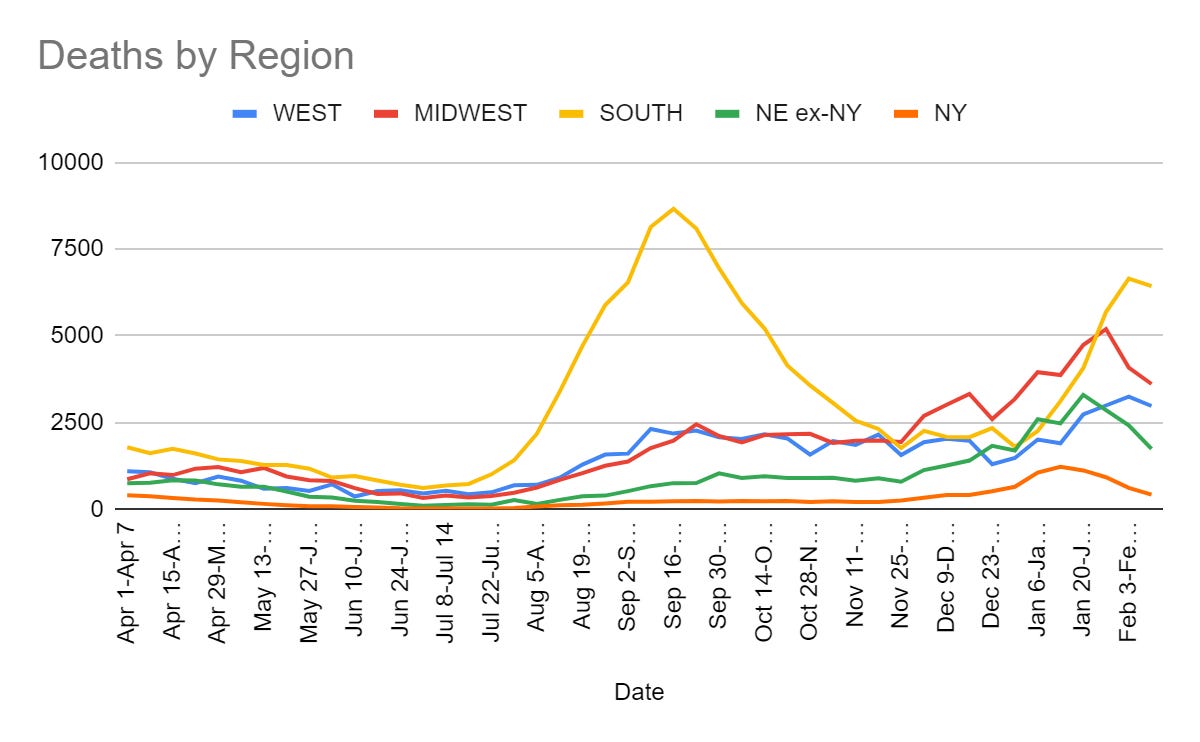
Deaths have variable lags so we continue not to see as much decline as we might hope for, but we see hospitalization numbers dropping steadily each day and next week we will be three weeks out from a dramatic case drop and four weeks from the peak, so we should see a larger decline. For cases, I presume behaviors will adjust so I expect a somewhat smaller decline in cases than before, but weather is increasingly on our side as well and I don’t think there is that big a behavioral adjustment in many places, and the Maine and Maryland thing is weird, so I still expect good results. We have had much lower case counts at various points last year.
Cases


Cases did not drop much further in the Northeast, and this map is a hint.
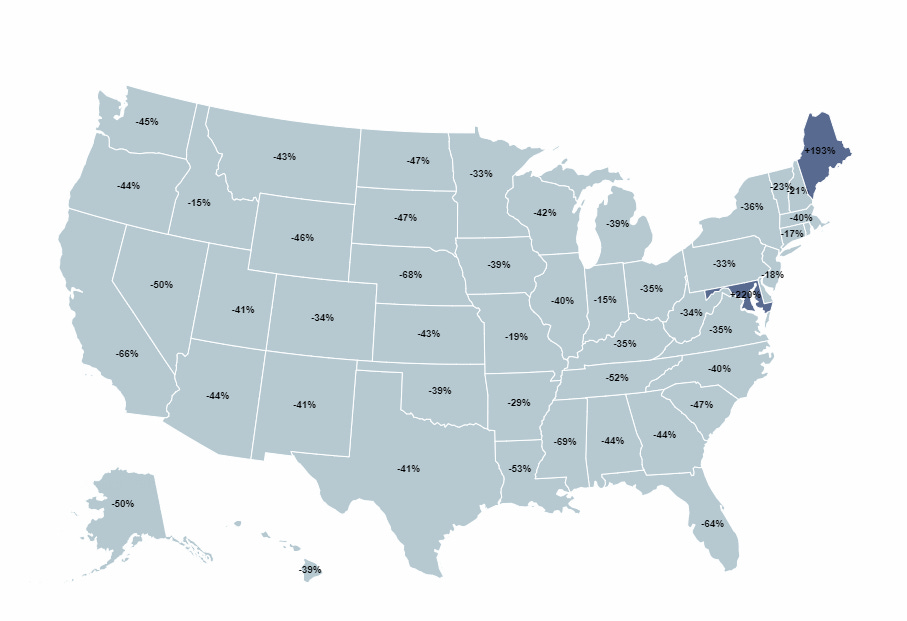
There are clearly some behavioral adjustments to the already-lowered rates, in a region with a lot of precautions to unwind, but the big thing is the dramatic rise in Maryland and Maine, which cannot plausibly be real, so I am presuming that is some sort of data hiccup.
Eric Topol offers my new favorite version of Don’t Stop Believing while painting the whole pandemic as a morality play (source Brad Delong, who shares his perspective).
Here’s the money quote from Topol. Wait for it (emphasis mine):
So where do we go from here? Is Omicron, by infecting “up to half the world’s population” going to serve as our exit ramp from pandemic to a contained, endemic state?
That isn’t clear and it would be foolish to predict that, even though that occurred this week
It would be foolish to predict the thing that already happened!
Predictions are hard, especially about the future, but they aren’t that hard.
Vaccinations and Treatments
Katja Grace asks some people why they haven’t gotten vaccinated, lists answers. The ones that confuse me are the ones who say essentially ‘I’m already not living my life so I’m not at risk so I don’t need the vaccine.’ That comes up several times. There’s also a faction that treats Covid as no big deal, and a bunch of people finding specific excuses that don’t seem like true objections. Of course, there’s a bunch of what is effectively ‘I don’t trust these lying liars and their so-called data.’
California introduces law requiring employers provide proof of vaccination. It will be ‘heard in committee’ in March, so conditions will be different when it is being considered. Strangely it only counts people whose second dose came within 45 days of their first dose, despite delaying the dose actively being more effective. That is often the kind of thing that hopefully gets fixed in committee, especially since it would render people permanently unemployable for being on the wrong side of it. Even more hopefully the whole thing will be moot by the time it gets that far.
FDA has approved Eli Lilly’s monoclonal antibody treatment bebtelovimab for use against Omicron.
I was pointed to this paper by a commenter.
Hyperbaric oxygen therapy for the treatment of long COVID: early evaluation of a highly promising intervention
Results HBOT yielded a statistically significant improvement in the Chalder fatigue scale (p=0.0059; d=1.75 (very large)), global cognition (p=0.0137; d=–1.07 (large)), executive function (p=0.0039; d=–1.06 (large)), attention (p=0.0020; d=–1.2 (very large)), information processing (p=0.0059; d=–1.25 (very large)) and verbal function (p=0.0098; d=–0.92 (large)).
Conclusion Long COVID-related fatigue can be debilitating, and may affect young people who were previously in economic employment. The results presented here suggest potential benefits of HBOT, with statistically significant results following 10 sessions.
My presumption is that this will have positive effects on some but far from all such cases, but it seems promising enough that one should be willing to try it.
Physical World Modeling
New pre-print says Omicron infection plus vaccination equals strong immunity against all variants, but Omicron infection without vaccination mostly protects only against Omicron. Small sample size, so not super reliable.
Omicron and Delta have recombined, but this was expected and so far not scary. That is my understanding of this as well, at least so far.
Chris Said points out that our baseline should be that infectiousness is linear in the amount of virus one is giving off, whereas the amount of virus given off rises and falls exponentially, so even though a person is in theory ‘infectious’ within a broad window in practice the window is much shorter.

He links to this study as an argument for why the threshold effect story is physically implausible. My brief look at that study found it making strange claims about the threshold hypothesis that did not match my understanding of the threshold hypothesis, including the claim that it requires the virus to ‘act cooperatively’ which sounds to me like some very strange misunderstanding.
In particular for Covid-19 I find the threshold arguments reasonably convincing and didn’t update much on this paper’s arguments, but the basic curve structure above should mostly still hold unless the necessary threshold is quite low. A half-time isolation job does a lot more than half the work. In many cases that is good enough.
Scott Gottlieb observes that BA.2 is increasing in prevalence, agrees that it is unlikely to change trajectory of pandemic, although he only refers to ‘current epidemic wave.’


I always find statements like this super weird:

Certainly if it is more than 10% it is going to take over. But also if it is less than 5% it is also going to take over. What matters is whether BA.2 > BA.1.1 in terms of spread, and there is no reason to assume the answer to that is different in different places. Either BA.2 is going to take over pretty much everywhere, or pretty much nowhere. Since it already did take over in some places, it is presumably going to take over the rest.
The pace at which it is taking over is sufficiently slow that this does not seem concerning, but it does mean the bar we have to clear gets raised once again, cancelling out some of the cases we got in this wave. I see no reason it should change our actions going forward.
Another study finds excess mortality after getting Covid.
Results: People infected with COVID-19 had more than three times the risk of dying over the following year compared with those who remained uninfected. Short-term mortality (up to 5 weeks post-infection) was significantly higher among COVID-19 patients (1623/10 000) than controls (118/10 000). For COVID-19 cases over 60 years old, increased mortality persisted until the end of the first year after infection, and was related to increased risk for cardiovascular (aHR 2·1, 95%CI 1·8-2·3), cancer (aHR 1·5, 95%CI 1·2-1·9), respiratory system diseases (aHR 1·9, 95%CI 1·2-3·0), and other causes of death (aHR 1·8, 95%CI 1·4-2·2).
Conclusions: Increased risk of death from COVID-19 is not limited to the acute illness· COVID-19 infection carries a substantially increased risk of death in the following 12 months. This excess death mainly occurs in older people and is driven by broad array of causes of death.
I notice all those ratios look the same and also that one of them is cancer.
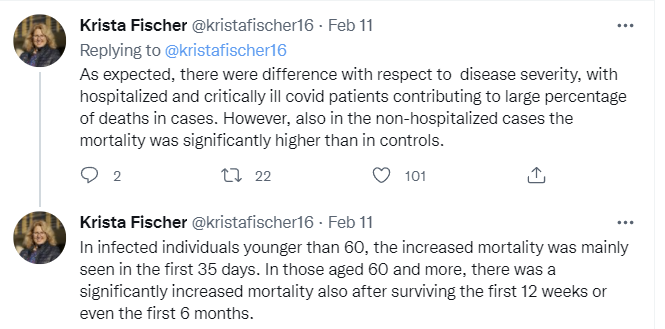

The reference (control) group (n=254,969) comprised an index date matched random subset of individuals insured by the HIF who were alive at the COVID-19 case index date but had no evidence of COVID-19. We used a case-to-control ratio of 1:4 (without replacement).[7]
…
To estimate hazard ratios, we used Cox’s proportional hazards model fitting two models: the base model (adjusted for sex and age) and an adjusted model. The adjusted model included all baseline covariates (age, sex, period, pre-index date Charlson comorbidity index, health care utilization intensity, and the county of Estonia).

The presence of the Charlson comorbidity index indicates they are at least trying at all to get reasonable controls, but once again the effect size here is gigantic and would show up in the excess mortality statistics on a nationwide level. 91% of deaths are before the age of 60, so if you do the math this predicts a ton of extra people dropping dead and it seems hard for that to be missed.
I also got asked again about this veteran’s administration data showing higher risk of heart attack, but this time it’s specific to heart disease you see, except that other places you see similar rises in heart disease exactly because of bad controls, and the controls on this one were obviously bad, and there’s no statistics showing a nationwide epidemic of heart attacks and other cardiovascular problems, and the a lot of the reason I wrote The Long Long Covid Post was to very slowly and carefully explain that all these statistical artifacts are exactly that and that to believe otherwise implies things about the world that we can observe are not true.
At some point if people who get Covid keep proving more likely to drop dead or suffer a variety of conditions and problems, yet the number of people who drop dead or suffer a variety of conditions and problems doesn’t include a correspondingly increased number of people, the only conclusion one can draw is those who are unlikely to drop dead and who do not suffer from and are not at risk for those conditions are unlikely to get Covid.
In any case, I will continue to update everyone when new information like this comes in, but it will take a lot to convince me things have much changed.
I do not know where the numbers come from and don’t agree with all of them, but I agree that this is a very useful way to show the data and the numbers aren’t crazy.
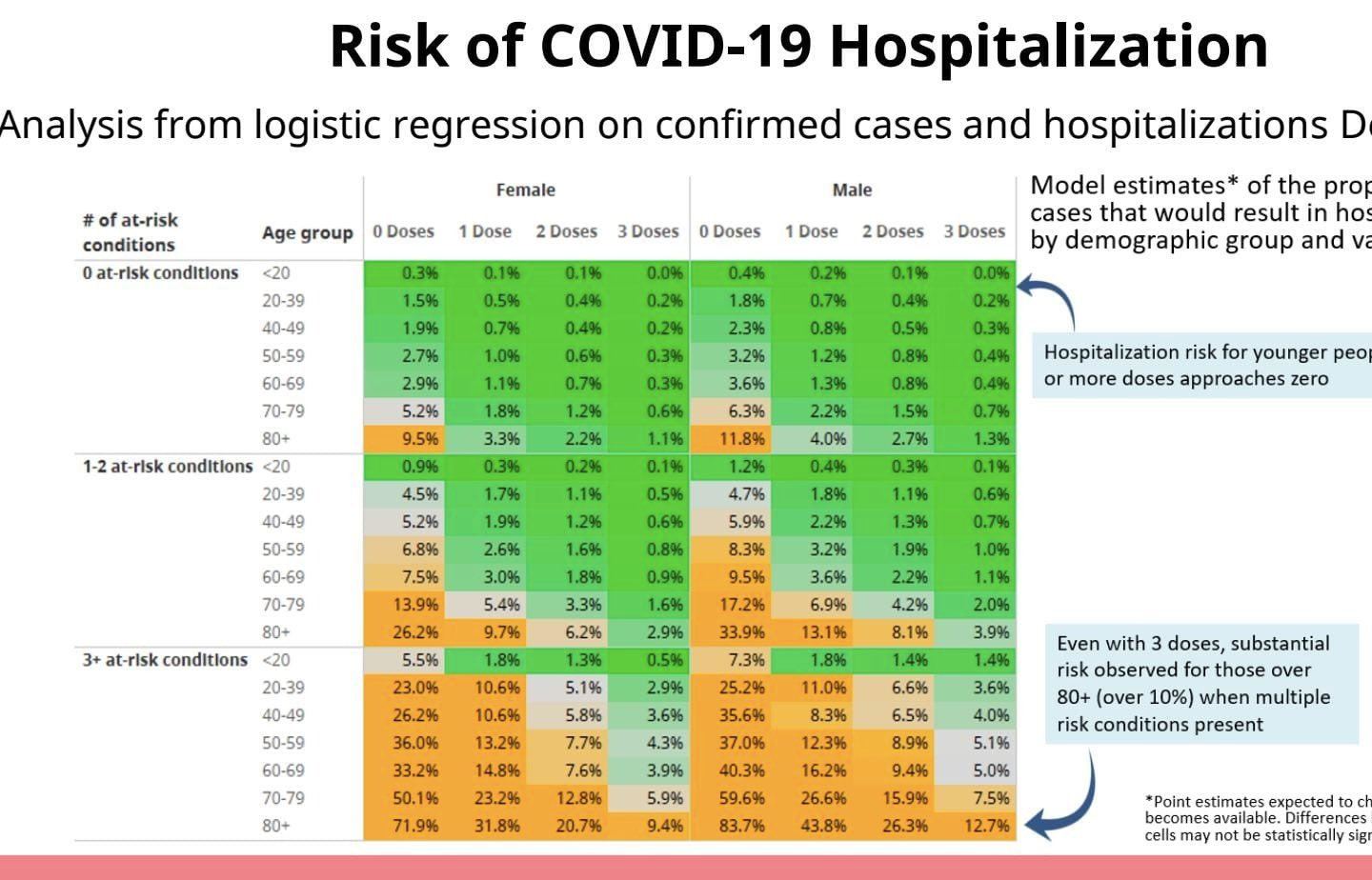
I do think these are at least sane estimates for Fermi purposes, to give you an idea how much age, at-risk conditions and vaccination matter.
Some thoughts in this thread about the causation behind the steeply declining Covid death rates, I’d question whether the true case count is being measured correctly here but the drop is real either way. Note that the scale on the right is logarithmic.
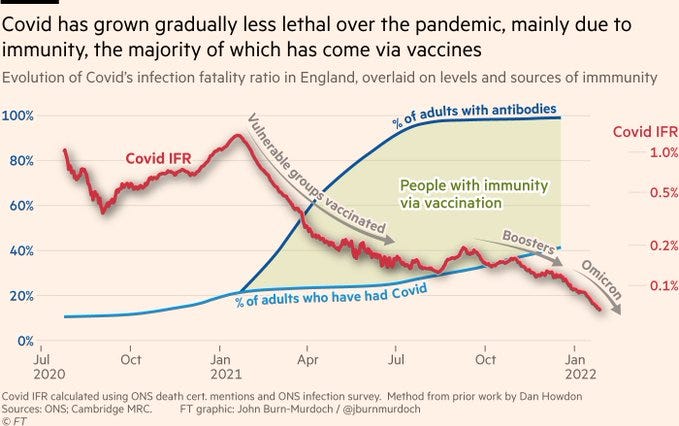
Prevention and Prevention Prevention Prevention
Even Germany and Austria are starting to let my people go, as are France and many others. Still a ways to go, as France is lifting its outdoor masking requirements now and considering the indoor ones in a month. It’s still a start.
Reminder: Please do not let yourself stress about things like ‘meet an old friend for a coffee.’ This is insane behavior, and a life lived constantly stressing about such things is going to be stressful and lack many of the basic joys of life. Live your life.
Michael Bang Peterson thread emphasizes the importance of pandemic management having an end goal, and that it needs to communicate that end goal to the public. One can attempt to control cases and spread, as a few places are still doing, or stop doing that and attempt to control disease. Also contains these interesting maps.
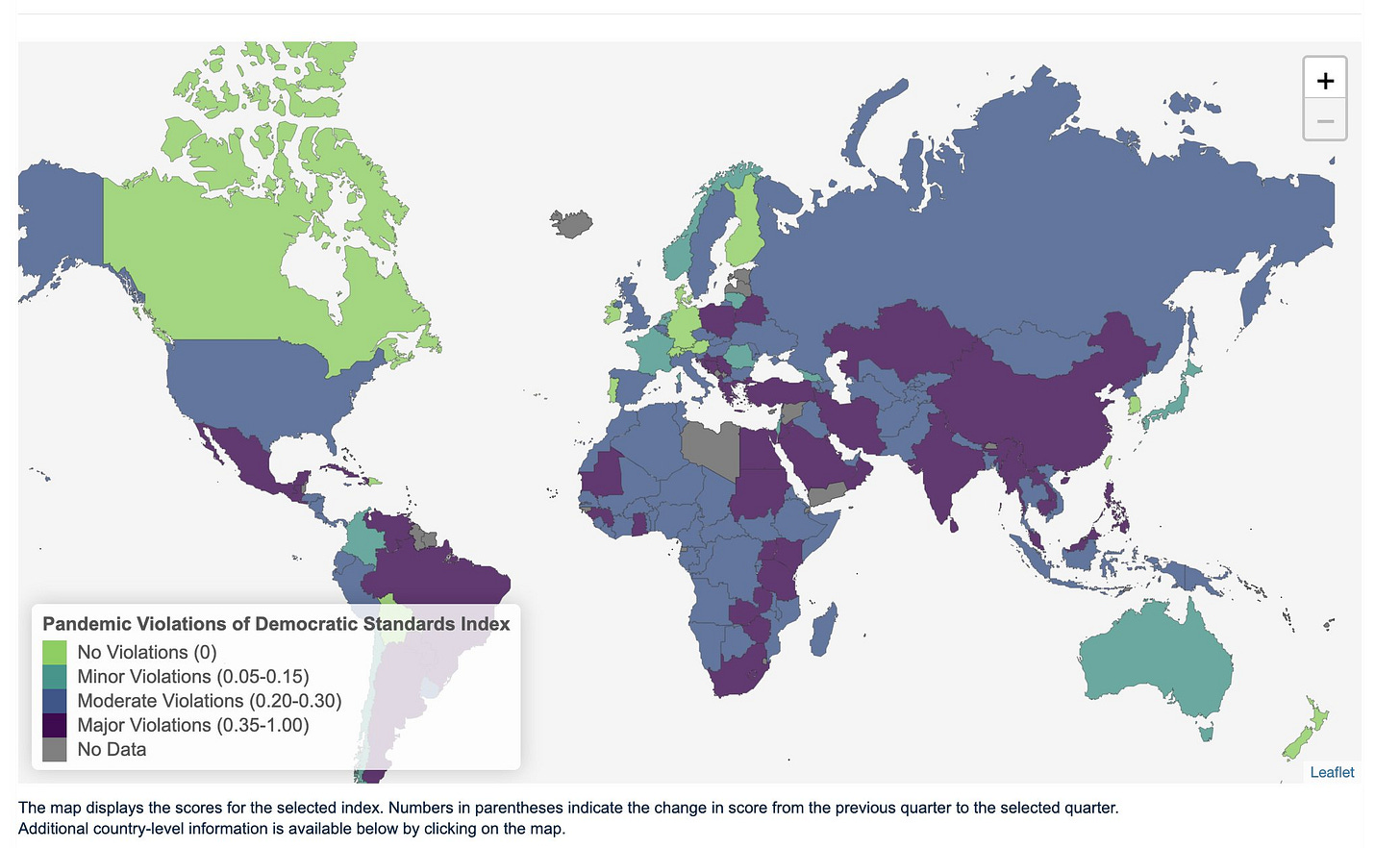
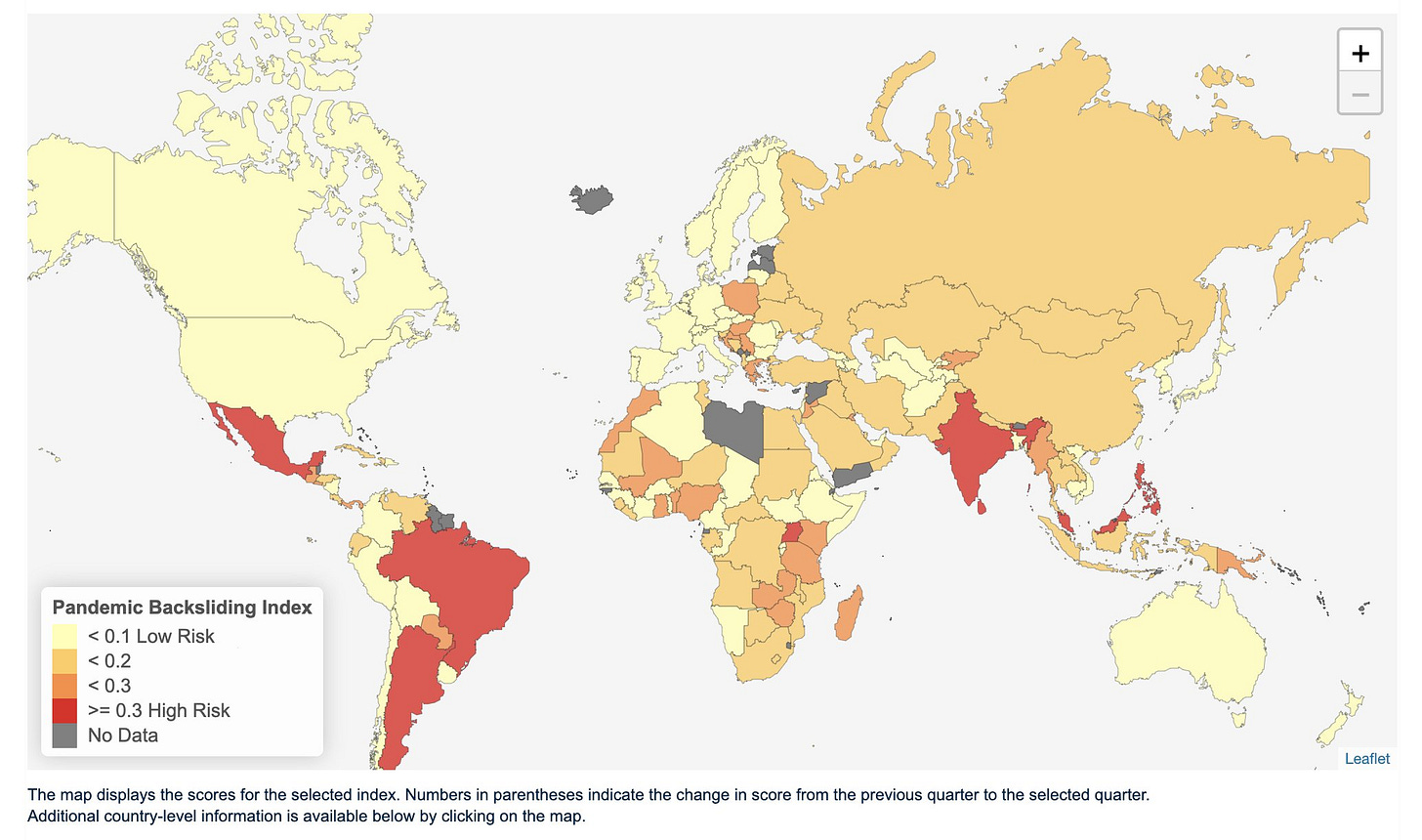
The Pandemic Backsliding Map refers to Democratic norms, and looks a lot like a general backsliding map. It’s not clear to me that the pandemic changed the colors of countries much. As I understand it, at least Mexico, Brazil, India, Poland and Hungary were already on everyone’s ‘democratic backsliding’ watch lists.
The first map is interesting as well. It’s not about whether the pandemic restrictions are violating people’s freedoms, it’s about to what extent the decisions about what freedoms to violate violated ‘democratic norms.’ Thus Germany, Canada and Australia come out looking good not because they protected freedom but because they followed a proper democratic process when agreeing not to protect freedom. That matters too.
He also cites two studies that frank communication laying out uncertainties and costs builds credibility and trust rather than damages it, whether or not it gets you the particular behaviors you want.
Opinions that remain widely held, offered without comment.


Ontario to lift vaccination requirements on March 1.
Quebec dropping the vaccine passport on March 14.
Are the protests making these changes happen, or are they making it more difficult to make these changes and slowing them down? The sign of this effect is not obvious to me, as there is good reason to expect such changes around now anyway. On net, I expect they did speed them up and my evidence is that the United States is seeing slower changes.
When I put out On Bounded Distrust, one commenter suggested Paul Krugman as an unusually good source that wasn’t looking to distort things to favor his own team, and the rest of us had to contain our laughter. In his latest, here he is equating those against masks with terrorists, who you see ‘endanger’ people.

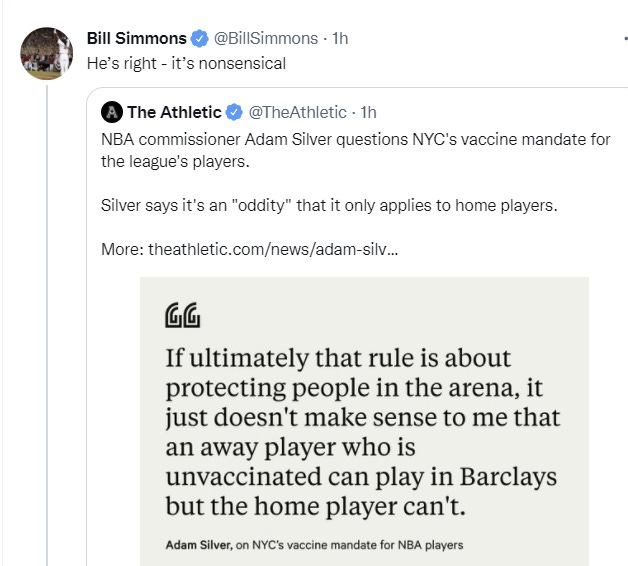
Presumably the reason is that New York implementing a rule that prevented opponents from playing would raise some strenuous objections, since it would give local teams an advantage, but the rule does remain rather silly.
CDC Delenda Est
Or perhaps we can offer an alternative that might be more palatable. Nolite audire ad CDC?


(If anyone knows of a good complete list of such CDC recommendations that no one takes seriously, let me know in the comments.)
Luckily this isn’t like Canada where there is a at least somewhat enforced rule that all burgers must be served well-done despite that being obvious nonsense, and you are free to add salt, munch on delicious cookie dough (there’s even a local place specializing in it and it’s solid and also when you’re done the rest bakes into a good cookie) and eat burgers cooked medium-rare as the good chef intended. And women are definitely free to drink without being on birth control.
Almost no one I know thinks any of those other rules should be enforced, so why should we be taking the same experts making those kinds of recommendations seriously when it comes to Covid, rather than taking it in exactly the light we take recommendations against eating cookie dough? That is, that these people are no fun and cookie dough is delicious and trivial risk is trivial.
The flip side of the same coin is that if the CDC wants to regain its credibility, as a first step it can end its opposition to medium-rare burgers and raw cookie dough.
FDA Delenda Est
Vaccine approval for young children is a big deal. Once such vaccines have been approved for long enough, the ‘but think of the children who can’t get vaccinated’ line goes away, making it easier to return to normal.
Does the vaccine work in such children? I don’t know, but what does work is being under the age of five so as long as the safety profile is fine I don’t much care. It’s not even entirely obvious that there is sufficient value in protecting such children, at this stage in the pandemic, that a placebo wouldn’t be as good or better if there are substantial next-day side effects. Certainly a not-maximally-effective vaccine that minimizes those side effects would be totally fine.
You’d think we were past the point in the pandemic where we could botch this one, except no, you would not think that. That is not a thing one still thinks. Of course the FDA can find a way to botch this (StatNews article).
Plans to attempt to authorize the Pfizer/BioNTech Covid vaccine for children under 5 before full data are available appear to have run aground.
The Food and Drug Administration on Friday canceled a key meeting of its vaccines advisory committee that had been slated for next Tuesday to discuss the submission, saying that the delay “will give the agency time to consider … additional data.”
Both the FDA and the companies suggested the application for authorization won’t proceed until there are data showing how well the vaccine works after a third dose. Those data should be available in early April, the companies said.


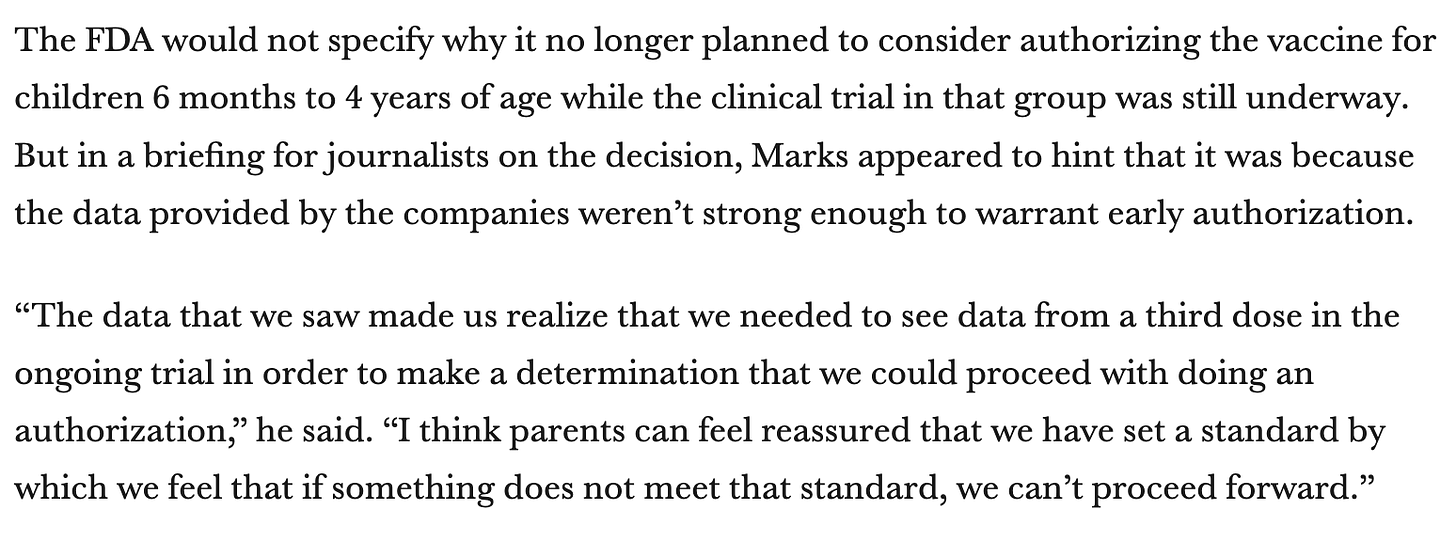
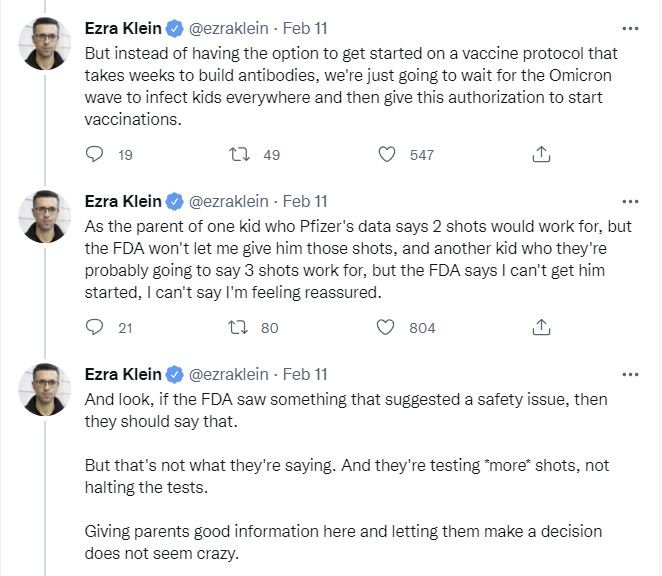
Technically, the application was postponed to wait for more data, but that’s another way of saying it would not have been approved and Pfizer knew that.
The reason the response from two doses wasn’t strong enough was that they used an extremely low dose. And why did they use an extremely low dose, you ask?

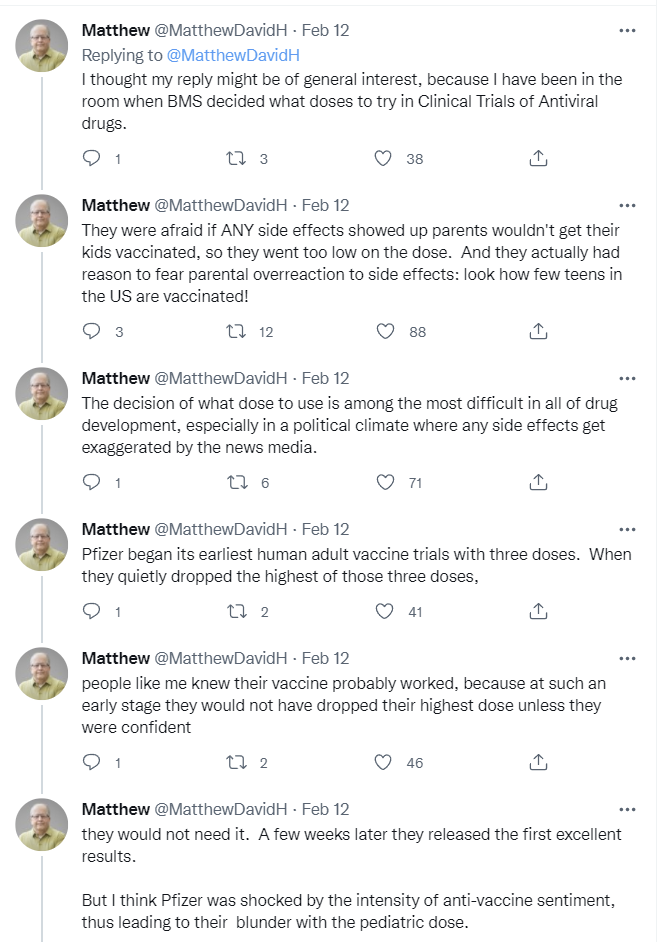
So in other words, because they felt the need to be completely safe even in the test, they used a dose that was not high enough to see results after two doses, and therefore they need a third. They cut the dose back because they predicted they weren’t allowed to use the right dose, and then were told the dose was too low so they need ‘more data.’
What’s even weirder is that it seems like the FDA explicitly asked for Pfizer to do the right thing and submit the application after two doses, and then changed their minds. Emily Oster explains:
Two Weeks Ago
Then, a couple weeks ago, Pfizer indicated that the FDA had asked the company to submit its documents now and request approval for the two-dose series, with the expectation of a third dose being added later. It was unclear what had happened to prompt this. Rumblings over the following week suggested that the higher case rates during Omicron had allowed the researchers to look directly at illness in children, with possibly promising results.
They planned to evaluate the data February 15th, with an aim of starting doses the week of Feb 21st.
Today
The FDA was supposed to post the “Panel Pack” today. Instead, they posted a statement postponing the meeting. There were “additional findings” as part of the submission and they are waiting for the third dose information until discussing. So, we are back to where we were in December.
WTF is Going on?
I don’t know, and I’m not sure anyone else outside the room really does either. There are really two options. One is that something emerged in the data review that was concerning. I think this is very unlikely, in part because Pfizer expressed confidence in approval after sending in the submission.
Instead, what I think is likely is that — as we knew in December — the two-dose series did not provide a very strong immune response in the 2 to 5 year olds. The rumblings about efficacy against symptomatic illness suggested a 50 to 60% reduction in illness risk, and that this was lower with Omicron than with Delta. This would be a reasonable but not amazing efficacy level.
Emily is forced to end with a call to parents to ‘not despair’ and a call to policymakers to start acting at least slightly less insane:
First: timing-wise, Pfizer has said their third dose data will be available in early April. At this point, it’s hard to say what will happen.
Second: please try not to despair.
Third: take a data breath. The risk of COVID to the vast majority of young children is extremely low.
…
Fourth, and hardest, and not for today perhaps: Think about moving forward without this. Yes, Pfizer might apply in April and this might be approved. But it might not. It may be time — even if you have unvaccinated kids — to consider the next phase of the pandemic. I sense that at least some of you are waiting for the vaccine as an “end”. It may be time to decide you are ready to move forward — baby steps first — even without a shot for now.
For policymakers: a plea. If you are not going to approve vaccines, please fix the quarantine rules for child care to allow test to stay or something else. It is completely unreasonable and out of the question to continue with the current system for months and months more.
So if I am understanding the situation correctly, here’s what we know.
- They set the dose low enough to reliably have actual no side effects.
- Two doses at that level are safe and have some effect (50%ish?).
- Three doses at that level are safe and likely have more effect.
- Zero doses are 0% effective.
- You need to do doses one at a time.
- The Omicron wave is rapidly ending, so most prevention value is short term.
- The FDA asked Pfizer to submit its data after two doses.
- The FDA then decided no, they needed to wait for ‘more data.’
- The FDA is in the meantime making vaccinating such children illegal.
- The FDA sure isn’t about to allow the higher dose we all know works great.
- The necessary data for the application won’t be available until early April.
- The kids in question won’t be vaccinated until after the school year is over.
- Meanwhile, such children continue to be placed under insane quarantine rules.
- Meanwhile, such children continue to be forced to distance and mask up.
- FDA Delenda Est.
This is yet another example of complete failure to do any practical physical world modeling or cost-benefit analysis. Allowing the first two (or better yet all three) doses now is all upside. Yet for some reason, we are ‘waiting for more data.’
Scott Gottlieb expects that even when these vaccinations are approved, they will be given ‘permissive recommendations (video) by the CDC.’ Thus parents would be allowed to protect their kids, but not told they were bad people if they didn’t. Which would be ideal if implemented now, but also the CDC’s wording seems unlikely to matter in terms of whether schools and others effectively force parents to vaccinate or not.
He also notes that the FDA is ‘cautious’ with young children and thus will be ‘careful’ in such situations, reflective of what counts as ‘risk’ being structured asymmetrically in a way that does not make any sense. The argument that ‘going back and forth’ is a problem could be easily solved as well by letting others make their own choices.
Finally, he congratulates the FDA on its excellent choice of temporary director, with a permanent one finally approved a year into Biden’s presidency. Quite the shade to throw on the new occupant. Dr. Robert Cardiff will now head the agency. I do not share Gottlieb’s love for the temporary occupant, but perhaps that is an error relative to plausible alternatives. It is hard to know.
Ministry of Truth
If you didn’t know who wrote this, what would you think?
Summary of Terrorism Threat to [the] Homeland
[This] remains in a heightened threat environment fueled by several factors, including an online environment filled with false or misleading narratives and conspiracy theories, and other forms of mis- dis- and mal-information (MDM) introduced and/or amplified by foreign and domestic threat actors. These threat actors seek to exacerbate societal friction to sow discord and undermine public trust in government institutions to encourage unrest, which could potentially inspire acts of violence.
The [this] and [the] in question is of course the United States, whose government now has moved on to complaining about not only ‘misinformation’ and ‘disinformation,’ but ‘malinformation.’ What is that, you ask?
Misinformation is false, but not created or shared with the intention of causing harm. Disinformation is deliberately created to mislead, harm, or manipulate a person, social group, organization, or country. Malinformation is based on fact, but used out of context to mislead, harm, or manipulate.
This sounds a lot like saying that using true information in a way power does not like is now to be considered incitement to terrorism. If you see something, say something.
Meanwhile those Very Serious People who see people living their lives with insufficiently serious concern often think about how they could change the Official Wording on various things to make these people appreciate their wise Narrative again.




The pure version:

So if we don’t like how people understand reality, change the language.
The bigger liberty and speech concerns this week are about the handling of the Convoy. Things on that front have sufficiently heated up, and there has been enough past discussion, that I’ve split that off into its own post again.
As a reminder, if you wish to discuss the Convoy, you are welcome to do that but please confine such discussions to posts whose title contains the word Convoy, and I will continue to commit to staying out of those discussions and giving my takes only in the posts themselves.
Matt Yglesias points out the reason people are more worried about an increase in misinformation is that we have more information. Thanks to the internet, we have lots and lots of information at our fingertips and are much better informed than in the past. The problem is that a lot of that information has always been wrong.
Think of the Children
Children react when told they don’t have to wear masks anymore.
At this point, those against this outcome are disproportionately childless.
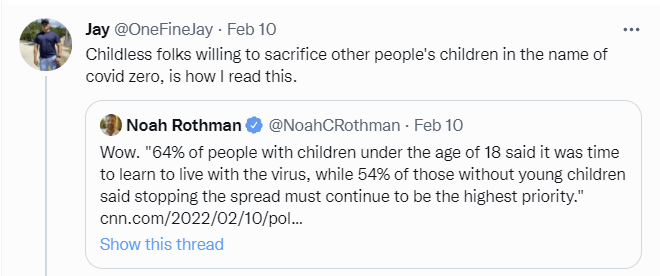

Those who aren’t parents are forcing children to keep masking up.

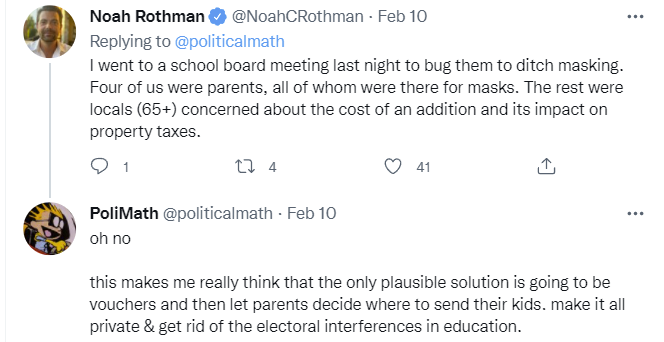
Then again, perhaps that interpretation is wrong, as this poll asks about mask mandates directly and finds a (small) majority of parents continue to support them, probably indicating a distinction between what it means to ‘learn to live’ with Covid versus lifting mask mandates in schools. Support for mask mandates in general is at a similar level overall.
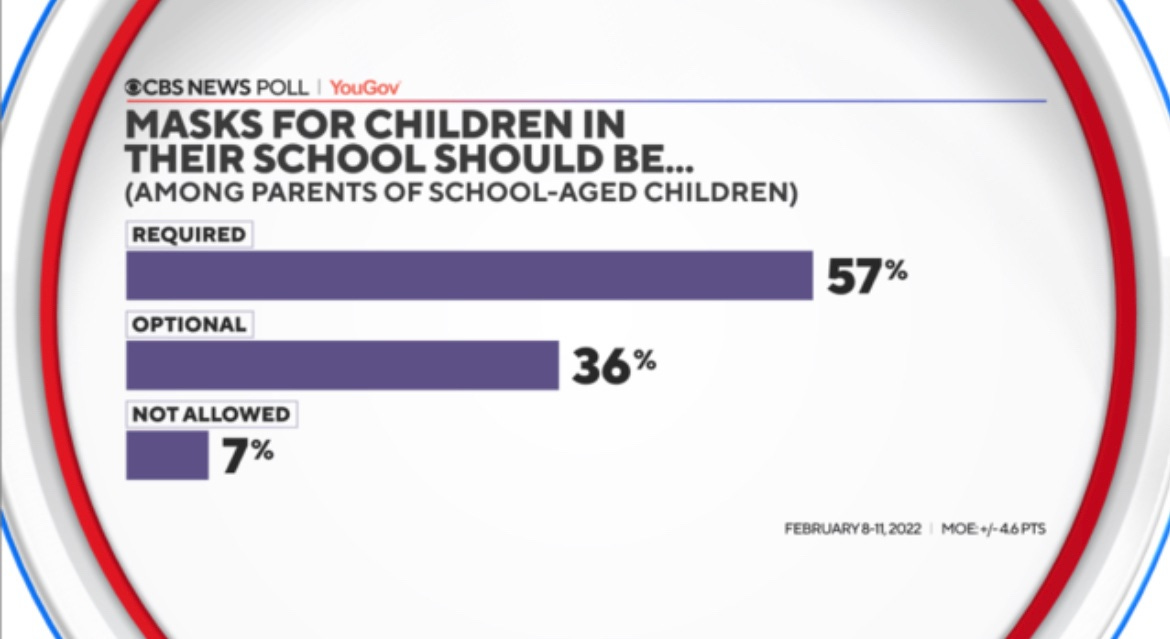
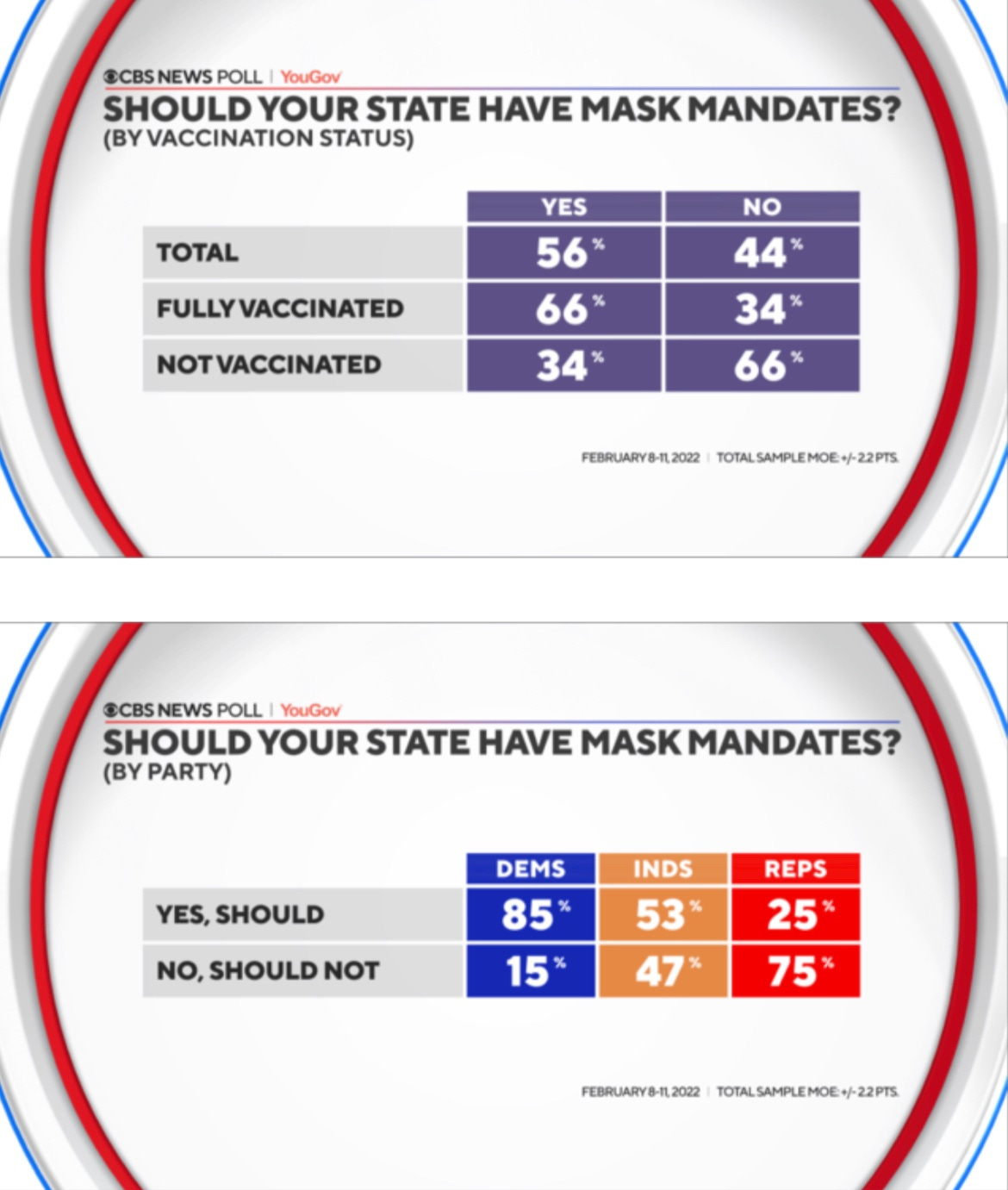
Support for school versus other mask mandates is similar.

I think this is right. What people want is normalcy, but if you ask them about a particular intervention you trigger a different set of automatic responses.
Either way, kids are required to outdoor mask and have those rules enforced on them, while the rules are very much not enforced on others. In other places, it’s not even enforcement, as (for example) DC lets bars eliminate mask requirements but not schools. Remember.
Older kids have been under state supervision for longer. In some cases, this has been sufficient to cause them to lose touch with the underlying physical reality and they have learned to play their part in universal social pressure games.

If you are wondering why the kids are enforcing 100% compliance and putting on conspicuous cheers, that is because this is what their teacher and other authorities told them constitutes the kids being alright. From their perspective, this is right. The point of school (aside from being a child prison and/or daycare) is primarily to teach children obedience to arbitrary dictates. Masks are a great object lesson in obedience to arbitrary authority.

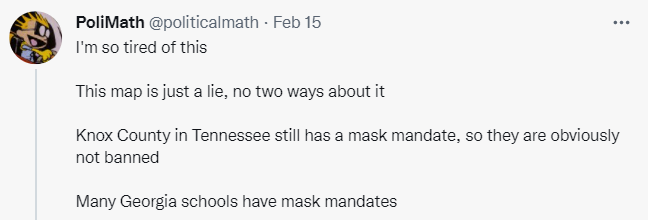
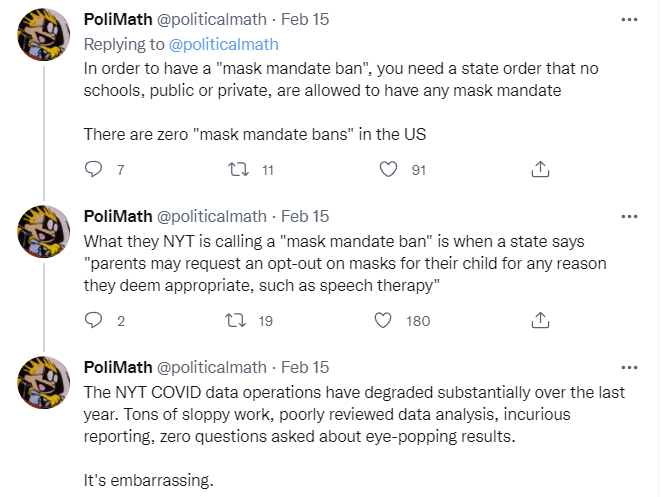
There are no mandates for lack of mandates because whenever anyone tries to mandate that, the courts mandate that such things not be mandated.
FiveThirtyEight asks when it is safe to lift mask mandates. To frame the question that way is to already answer it with a quiet ‘never.’
The true answer, of course, is that it was always safe, and it is especially safe now.
It opens with the traditional ‘safe’ fallacies of comparing to other times rather than absolute numbers, and also looking at the present rather than looking forwards.
Maggie Koerth: I thought that it would be good to just set the stage. Right now child cases of COVID and child hospitalizations from COVID are still up compared to where they’ve been previously in the pandemic, but you also have at least four states moving to end mask mandates in schools. I’m wondering if that feels confusing to you.
All of that is smokescreen, as always, because it implies that the reason for schools to require masks is danger to the children which is complete obvious nonsense.
It goes on like that, including this gem.
Maggie Koerth: I’ve seen situations where things like masking mandates are working, but then case numbers fall and we get rid of masking. Is that really the way that we should be approaching this? Getting rid of the things that lower case numbers when the numbers are lower? Or is that just setting us up to have high numbers return?
Megan Ranney: Let me make an analogy: We have decreased the number of car crash deaths on a per child basis over the last few decades by developing and using safety measures like car seats. But the fact that we have decreased the number of deaths does not mean that we should get rid of those things that we put in place to make death lower. It doesn’t mean we should stop using car seats!
Actually we should at least stop requiring car seats. Requiring car seats is one of those silent monsters that makes having children far more marginally difficult than one thinks, including making various people paranoid about not having car seats for children obviously too old to need one. In order to swap cars, technically, one has to do this whole ring-a-ma-role and you’re supposedly never supposed to take a normal taxi. Luckily most people realize this is all mostly obvious nonsense, but even with that the number of children not born due to this problem is higher than one might think.
The car seat metaphor also presumes a static situation requiring continuous prevention, which is completely not applicable to this situation. And it presumes that the mask mandates are what causes the lower death counts in general rather than being one of many, many factors, again obvious nonsense. More morality play, from people who should know better. Which also explains the obsession with vaccination rates in children, despite children being far safer without vaccines than adults are with them.
The conclusion is of course that the same old metrics that applied when we were trying to suppress the virus and the virus is much more deadly should continue to be our guide for some reason.
The kind of simple, easy thing that I’ve been telling folks is somewhere between 50 and 100 cases per 100,000 people per seven days.
You simply cannot kill this obsession with average case rates, or even shift the baseline.
In a piece centrally about the lost art of the slate pitch, there’s this section which seems on point in its own right.
Today, publications are all the same.
Here are some headlines:
- Your co-workers with kids are not okay [2/14/22].
- The parents of the youngest children are not okay [1/20/22]
- Parents are not okay [8/22/21]
- American parents are not okay [2/2/21]
- Parents of the youngest kids are not okay right now [1/13/22]
Those all ran in different, once-distinct publications. And it’s not just America. According to Macleans from Canada, “The Pandemic is Breaking Parents.” One could almost say that Canada’s parents are not okay.
One of those stories about how parents are not okay ran in Slate, and it’s a pretty good story. It expresses what all the “parents are not okay” stories express, namely the unique frustrations of pandemic parenting in an environment where kids have been last in line for vaccination but first in line for NPIs in a way that’s very stressful and annoying. That said, what I think they would have told you at Old Slate is that parents actually experienced better mental health during the pandemic than non-parents. The stresses of being cooped up with kids were real, but the boredom and isolation of living alone was, for many people, worse. And if you think about human history in the long run, having kids underfoot while you’re trying to get your hunter-gathering or subsistence agriculture done is difficult but a reasonably normal experience in a way that being all alone in a house for weeks at a time is not.
The depressing aspects of isolation are probably rendered all the more depressing by the fact that you’re not even supposed to complain. How are you going to whine about being sad there’s no happy hour and running out of stuff to binge-watch when your coworker is supervising two kids on Zoom school and nursing a half-dozen (valid) resentments about how unhelpful her husband is? No one has had it easy the last two years, and in many ways, the tasks facing your coworker are objectively more difficult. But that very social undesirability of insisting that “actually parents are dealing with the kind of stress that humans are well-adapted to while singles are forced into a weird psychic torment” is exactly why it was valuable to have a publication like Old Slate around.
Definitely a lot of people are not okay, and if these effects were considered as their own pandemic it would be a super big deal and everyone would be freaking out quite a lot and rightfully so. Whenever I think about Long Covid, I think about the comparison to Long Covid Prevention, especially for kids but also for everyone else.
I also agree about the lost art of the slate pitch. I had a principle to almost never read such pitches, but they still provided a valuable service.
Misinformation
Another data point for the bounded distrust calibration.
Misinformation takes many forms. One of them, it seems, is a journalist getting a false impression, ignoring all attempts to correct it, then this getting picked up as ‘a study’ and becoming part of the Narrative including being used to justify proposed policy.



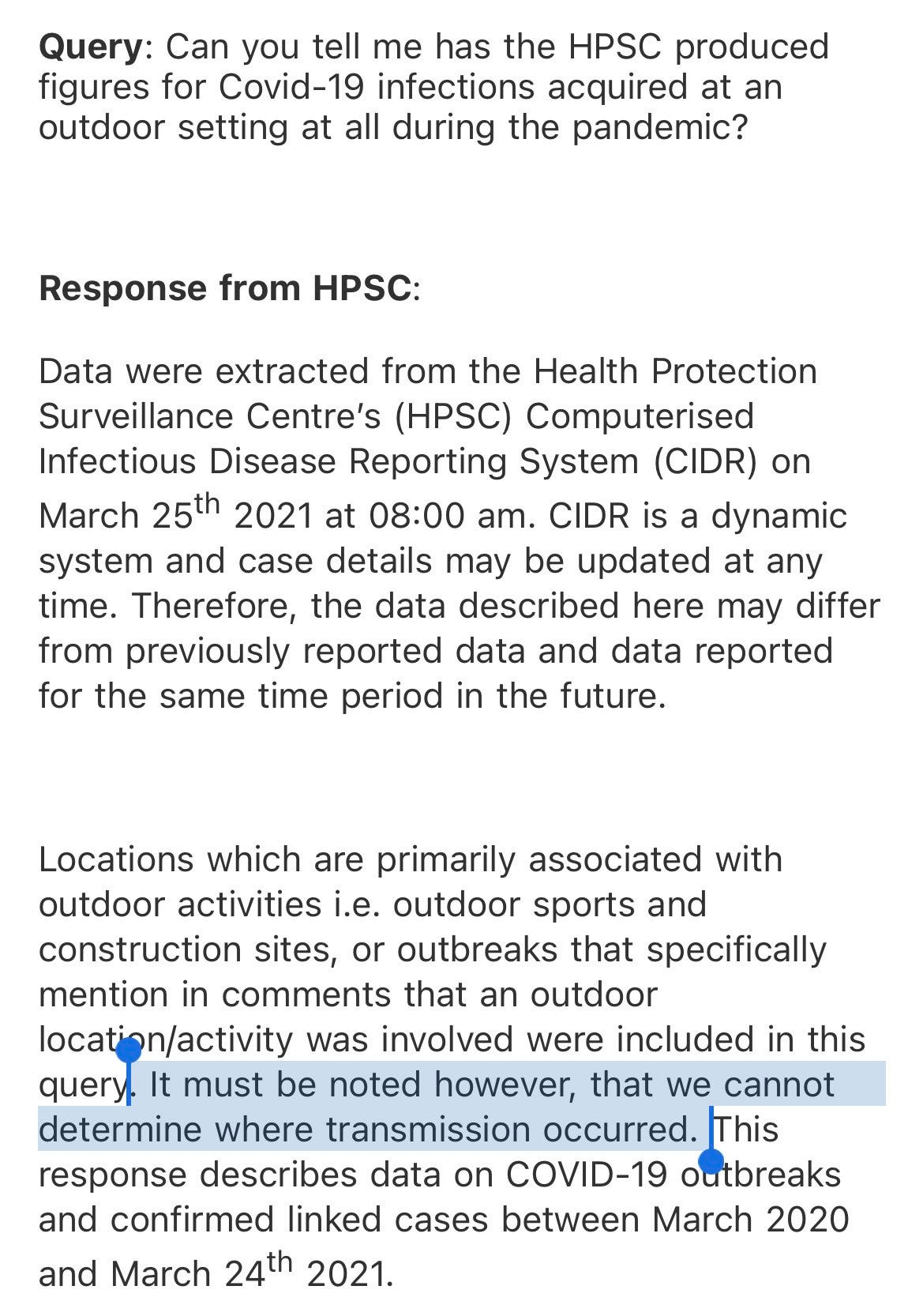
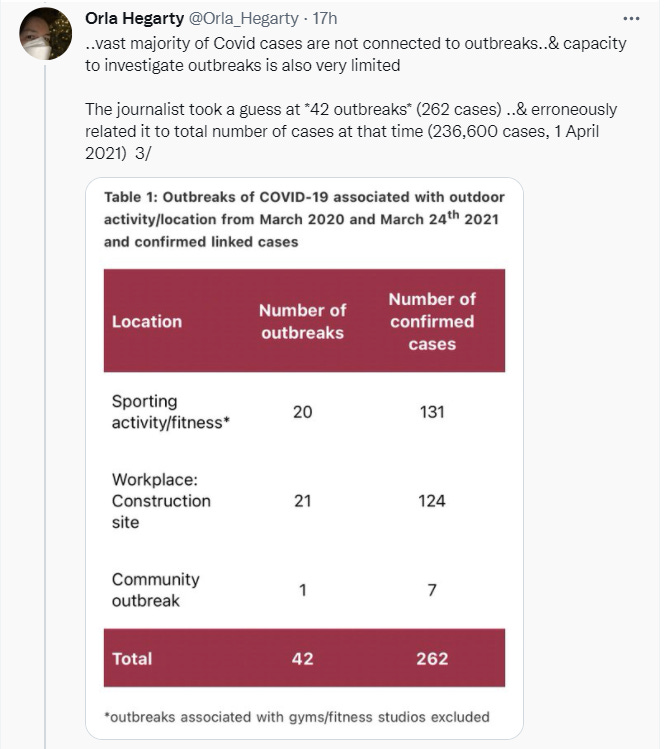


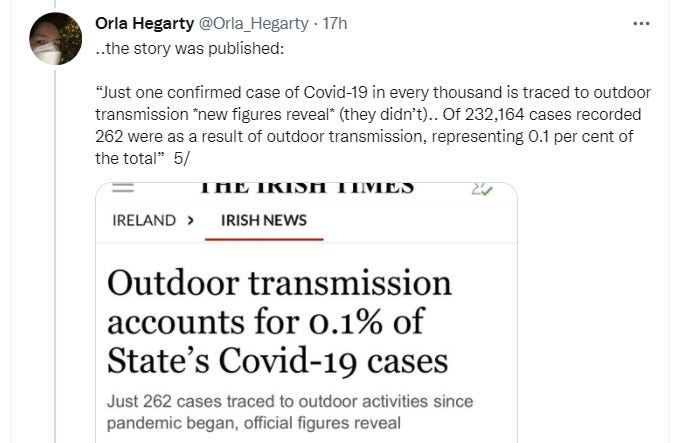
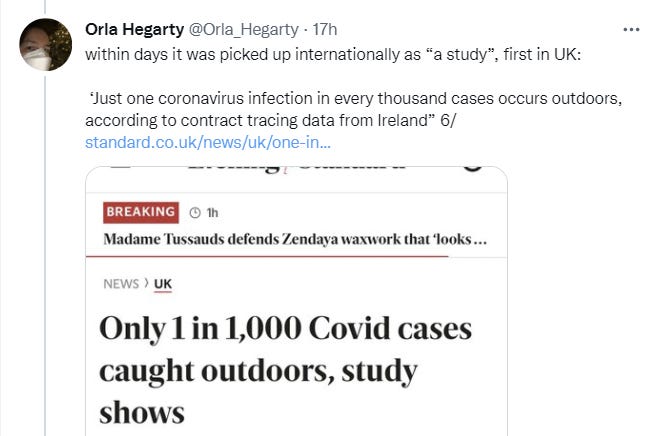
Link to post from #6, which links back to the first post. It opens like this:
Just one coronavirus infection in every thousand cases occurs outdoors, according to contract tracing data from Ireland.
It also includes this quote confirming that yes, this has gone exactly this sideways.
According to the data, published by the Irish Times, there were 42 coronavirus outbreaks associated with outdoor gatherings, with one community outbreak accounting for seven infections.
The HSPC said it could not “determine where transmission occurred” and explained that the data is based on locations which are mostly associated with outdoor activities, such as outdoor sports and construction sites.
And yes, the OP is as dumb as Orla claims, to even write the claim in a sentence is to realize it is absurd and we couldn’t possibly know this.
Of the 232,164 cases of Covid-19 recorded in the State up to March 24th this year, 262 were as a result of outdoor transmission, representing 0.1 per cent of the total.
The post also cites several other studies that found negligible outdoor transmission, because outdoor transmission is indeed very rare, but the evidence that is now being cited over and over is a confusion and also patently absurd and no one stopped to think about it for five seconds.

Mommy, what is a fact checker?
A bunch of other journalists (including the NYT again) keep repeating it, and then it gets into medical journals (13, 14)


And so on…



There are more examples in the thread. I very much doubt this is an isolated incident.
I am curious to what extent this was able to happen because the actual conclusion people drew from all this – that outdoor transmission is a trivial risk and should be ignored – happens to be true. Outdoor transmission is a trivial risk and should mostly be ignored.
This certainly had some impact here. The made-up ‘findings’ although extreme were plausible and rhymed with other true observations (I am guessing outdoor cases are substantially more then 0.1% of all cases, although it would not shock me if it was <1%) The conclusions and recommendations that followed were right and positive. So, sure, it wasn’t ‘true’ but it had truthiness. It was telling a generally true story, and people noticed that, and didn’t notice the opposite.
Yet the media also published on the regular stories about how these awful people were congregating on the beaches during a pandemic, how dare they have fun when they should be repenting for their sins. And that also seemed true at the time, and those involved believed they were pushing a right and positive Narrative, except they were very wrong about that.
I mention that example only because it’s the direct opposite message of the story here, not because it is otherwise that fitting an example.
More and more it seems like misinformation always has been everywhere, and things like this are nothing new. It’s not like Americans have ever had good scientific understandings, or reporters have known much better than chance which of wet ground and rain causes the other. If anything, Scott Alexander claims that on scientific claims the media is much better than it was only a decade ago because it is much easier to call them out on such nonsense, forcing them to keep an eye on the nonsense level.
There is a real issue with polarization, but that’s distinct from misinformation. Often more information, especially given how such information is selected, increases polarization or leads people to conclusions that are wrong and/or anti-Narrative.
The problem of ‘misinformation’ is thus often not a case of false information at all, but rather a case of not generally known true information that is caused by and leads to a different emphasis and interpretation of the situation than the Narrative.
So what about misinformation? It turns out that getting offline “reduced both factual news knowledge and political polarization.”
…
When I went on The Joe Rogan Experience in early December of 2020, he surprised me by veering way off-topic to do vaccine-skeptical takes.
Since this is not what my book is about and isn’t something I had professional background covering, I was not prepared to rebut his talking points effectively. That’s especially true because, at the time, the Covid-19 vaccines were loosely Trump-branded, so I wasn’t really expecting this to be a controversial issue and hadn’t looked into it. Which is just to say that Rogan was actually much better informed about the vaccine issue than I was. He (correctly) said the common, non-severe side-effects were considerably worse than I realized. And he also correctly said that the Phase III clinical trials were not long enough to gauge how enduring the protection the vaccines offered was. He, as a vaccine skeptic, had sought out a lot of vaccine skeptic talking points, and many of those talking points were factually true.
I, a normal sane individual who supports vaccination efforts, never bothered to look into anything about it other than when was I going to be able to get my shots.
But this is actually the general pattern in life. A normal person can tell you lots of factual information about his life, his work, his neighborhood, and his hobbies but very little about the FDA clinical trial process or the moon landing. But do you know who knows a ton about the moon landing? Crazy people who think it’s fake. They don’t have crank opinions because they are misinformed, they have tons and tons of moon-related factual information because they’re cranks. If you can remember the number of the Kennedy administration executive order about reducing troop levels in Vietnam, then you’re probably a crank — that EO plays a big role in Kennedy-related conspiracy theories, so it’s conspiracy theorists who know all the details.
If you go out seeking lots of information that supports your position, the world contains quite a lot of information, so you will doubtless find some of it that supports your position. If you then also do not seek or selectively ignore the information that does not support your position, and use some amount of motivated reasoning and emphasis, one often has no need for misinformation. Whether you’re the one seeking such information or not, you need to compare the results to what one would expect to find, rather than to the null result, to preserve conservation of expected evidence.
Rogan is wrong about vaccines, but that doesn’t mean his facts above were wrong. His mistake was that he did the cost-benefit calculation wrong.
This is similar to bounded distrust. I will occasionally end up fooled by something completely made up or false, but I don’t put all that much effort into fact-checking stuff and it is still pretty rare. Almost all of the problem comes from true or at least not-false things selected and presented in a motivated way, which can cause false interpretations and conclusions.
There is definitely a lot of misinformation out there. There is still a ton more true information, the proportion of misinformation does not seem to me to be rising, and most of the ‘misinformation’ I see is centrally people emphasizing the wrong things and wrong reasoning, to justify what the right people think are the wrong conclusions. I do think importantly discourse is getting worse, people’s ability to think and to do real things is declining and under increasing threat in various ways and partisanship is increasing, but these problems should not be conflated.
This is the most common kind of ‘misinformation’ situation, which depending on details can go both ways but on this one I’m with Matthew:
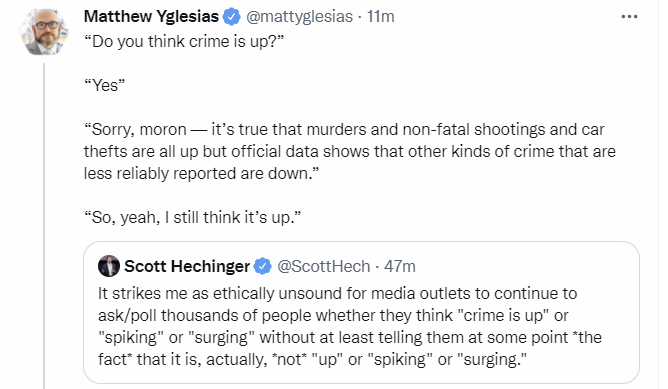
In Other News
Levi’s brand president accused of all the isms, told to go on an apology tour and forced out for saying true things about Covid and wanting her kids to go to school, gives up severance of $1 million to avoid an NDA.
Some correct implications of only doing prevention you’d consider doing permanently.
An analysis comparing microCovid to another Covid risk calculator that may work better for large gatherings. The new one is from MIT. Such calculators are useful intuition pumps to remind one of the importance of power laws and allow Fermi calculations, but I’ve noticed they also have a tendency to give absurd numbers at times, so also use common sense.
Netherlands nightclubs open in defiance of the rules. Will they make it stick, or will the rules be enforced?
Hong Kong has a large Covid outbreak. Xi is responding by saying HK’s goal is to contain Covid-19, but it is obviously far too late for that. Yet Xi has little choice if he is to maintain his zero-Covid policy for the rest of China.
Hopson has another insightful thread on NHS about working through their Covid backlog. A key point is that a lot of people didn’t bother coming forward to request care before, so a growing waiting list does not mean things are necessarily getting worse. It also means a lot of uncertainty about the true size of the backlog. They are making progress, but he works to lower expectations because NHS budgets have only been going up 1.5% in real terms for a decade versus an old average of 4%, which he says leaves them understaffed (not doubting, simple can’t speak to it).
Sam Bankman-Fried illustrates how much people suck at interpreting and presenting scientific studies using an example from last year about masking in schools, including illustrating the problem by making a math error. Even when not doing proper controls and taking everything at full face value, yes the result is ‘significant’ but the effect size is small enough that the intervention in question does not seem worthwhile at all.
New York City restaurants now back to 75% of pre-pandemic levels, but offices remain at only 29% of their pre-pandemic levels. Why the difference?
“Going to a restaurant for an amazing meal? Worth it,” this person told The Post. “Commuting to sit at a desk for eight hours when I could do that from the comfort of my own home? Not so much.”
That’s not the company line taken by managers, some of whom are frustrated by employees’ unwillingness to get back to the office even as they partake in all sorts of New York City nightlife.
“If you can belly up to the bar at STK, you can be at your desk at UBS,” one cynical Manhattan-based CEO told The Post of the ubiquitous steakhouse chain.
…
“You can’t run New York City from home,” Adams said last month. “That accountant from a bank that sits in an office — it’s not only him. It feeds our financial ecosystem. He goes to the cleaners to get his suits cleaned. He goes to the restaurant. He brings in a business traveler.”
It is odd to me that the adjective cynical gets used here to describe the CEO. As a matter of health risk the CEO is absolutely right.
This is not about health.
This is about people wanting to go to restaurants but not wanting to go into their offices, because going into restaurants is nice and going into offices is mostly terrible.
The cost of going into restaurants is slightly higher in terms of health, annoyance and dollars, and people are out of the habit and not coming into the office, so they’re down a bit.
The cost of going into the office is having to be in the office all day doing what is likely a bullshit job and definitely involves a lot of wasted time and a lot of ‘being on.’ Before there was little choice, you either came in or you didn’t have a job. Now people have learned they can work from home and others have to let them, and they are taking that opportunity and staying put with it. Kudos to them.
I could not agree with them more. Back when I worked at Jane Street Capital, I had an amazingly great set of coworkers and a fully cooperative atmosphere and a job that totally required close real-time coordination and communication, everything was super casual where it didn’t impact the business, the job was real and interesting, and I still ended up hating it because I am simply not built to have to ‘be on’ all day every day with people constantly around me. Whereas when I was trading from home in other jobs where all that mattered were the results, then I was in my element. If I’d been able to trade from home somehow, I would have jumped at it, and maybe things turn out very differently.
Not Covid
America’s Finest News Source, in top form, covers the dismissal of Palin’s libel suit.
From Matthew Yglesias’ article above, a quote I feel the need to share:
My favorite study about how Facebook is bad finds that it follows what you’d essentially call an addiction or compulsion paradigm. If you give people a cash incentive to turn off their Facebook account, they spend more time watching TV but also more time socializing with friends and family. This leads to an increase in their subjective well-being (i.e., they’re happier) and generates “a large persistent reduction in post-experiment Facebook use.” In other words, people struggle to go cold turkey. But once they do, they generally like it.
San Francisco has recalled three members of its school board by overwhelming margins.
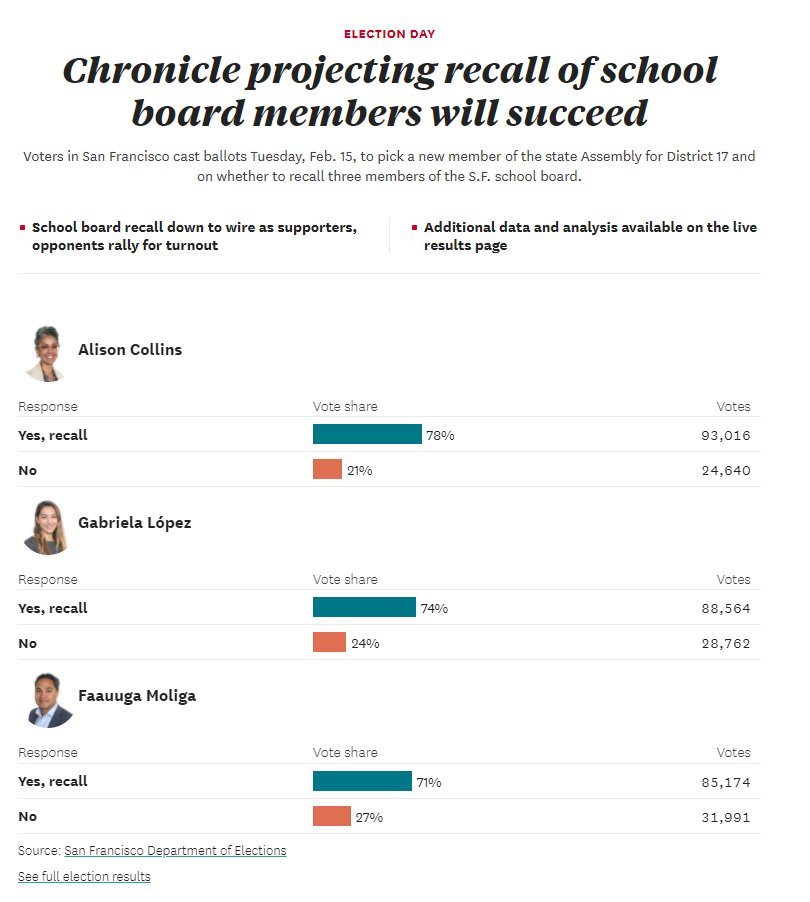

The argument is now over why people voted the bums out. There are so many good choices. The obvious guess is their Covid-19 policy of not finding a way to open the schools for a very long time and not giving schools their needed resources. Close behind is their decision to focus on other things instead, such as shutting down gifted and talented programs in a city seeking to nurture, attract and keep tech companies because “merit is racist and the antithesis of fair”, and renaming schools named for such awful people as Abraham Lincoln and Dianne Feinstein, with a third of names being deemed ‘inappropriate.’

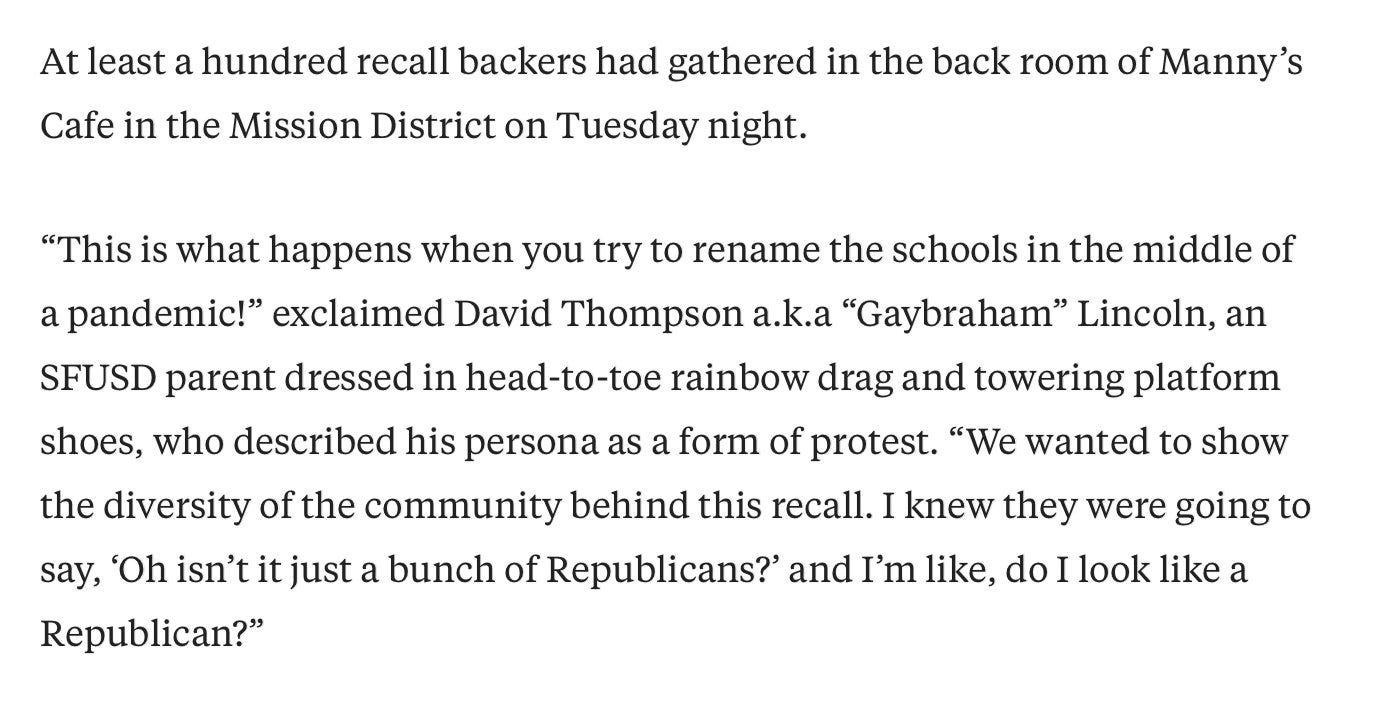
I presume that the reason the recalls won with over 70% of the vote is because parents had different priorities than this, and wanted their children in school or even educated.
As an extended off-topic aside also from the SF area, The University of California at Berkeley made the mistake of being in Berkeley, and now those around them have used environmental law to (unless something changes) force them to rescind 2,000 student acceptances because they did not “study the impact” of adding more students.
But this was never the point of the CEQA law, they say. It was about environmental protections, they say.

I mean, how could people possibly treat the situation this way?

I mean can you imagine?




Yes, I can imagine. Also I can expect it. That is what people do, they stop others from living near them. If you give them a law that gives them grounds to do that, they are going to do that, of course they are going to do that.
You either allow neighbors a general veto over what is built, or you don’t.
This was all at best a misunderstanding, and mostly gaslighting. Of course this is what such laws are for. They are for preventing people from ever doing anything.


The lack of interest in this is indicative of the true situation.


> I notice all those ratios look the same and also that one of them is *cancer.*
You say this as if covid affecting cancer prognoses is implausible. One obvious mechanism is people who had cancer before they got covid suspending their immunosuppressive cancer therapies until they got clear of covid (which took longer than normal, because they started immunosuppressed). This gave the cancer a chance to grow, metastasize and mutate unchallenged, which was not undone when the treatment regime resumed.
I mean sure I can come up with a Just So Story same as everyone else but it’s a very different causal mechanism and yet it is coming back at exactly the same ratio, etc etc.
This seems strange, and the vaccine reducing all-cause mortality seems strange too. I haven’t seen a good explanation for either
Lockdowns & COVID restrictions having heavy confounding effects, and being phased out as vaccination levels rise? (Anti-lockdowners have been asserting this since the first lockdowns in the West)
Workplace vaccine mandates like this CA bill are fighting the last war at best. They made some sense in the delta times when the vaccines had an effect on transmission that was distinguishable from zero. In the age of omicron, the only mandate that might actually benefit anyone would be a mandate for over-50s to keep hospital crowding down.
It is unnecessary in a epidemiological perspective, but very good Display Of Allegiance (read Havel’s The Power of the Powerless), which is the way it can turn out forward.
I’d prefer tweets like daniel_eth’s here weren’t included in these writeups. A guy on twitter knows an unnamed guy who has a dumb opinion. So what? You have great analysis, don’t dilute it.
Understood, thank you for the feedback. I typically only do it when I feel it is representative.
Regarding child car seats – remember that meme about outdoor seat belt? Well, I give you this thing (for a low, low price of 170 bucks) https://shop.saferide4kids.com/products/ridesafer-travel-vest
It adjust the seatbelt, so it’s not exactly completely useless, but same thing could be achieved by a 5 dollar piece, but it would be, of course, not an Officially Approved device.
I agree that the CDC is ridiculous, but one could argue that the examples provided (salt intake) only affect the individual while not wearing a mask potentially affects those around you, similar to second-hand smoke (though if one is wearing an N95 mask, why would you be that concerned that those around you are unmasked),
I don’t know other examples, but to me this is far more damning of the CDC: https://reason.com/2022/02/16/cdc-rochelle-walensky-masks-schools-covid-leaked-audio/
I would be more upset about the FDA child vaccine delay if I thought that we wouldn’t jump straight from permitted to mandatory. It’s a harder question to justify something being mandatory.
Yes, that shouldn’t be connected, neither logically nor by the FDA’s mission. Nonetheless politically they are connected, and everyone knows it.
I’ll second this. I’ll go further: The FDA should never approve pediatric vaccines for the under 5 population. Because approving them (or even issuing EUA) is de facto equivalent to mandating them.
I would however be OK with the FDA approving a saline shot for the under 5 as a purely placebo vaccine.
If the goal is shutting the mouths of those saying “think of the babies who haven’t been vaccinated!”, then stern, partisan words will do. No need for Pandemic Theater. (The vaccines already mandated for babies and young children [sub-5yrs] usually are for diseases with higher lethality.)
Let’s go the other way and mandate seasonal flu vaccines for everyone, and better use vaccine passports everywhere and permanently, because you can die from seasonal flu and all the flu strains are mutated from the Spanish Flu! /s
Exactly right. Being upset at the FDA for this is a bad take.
Surely there are better ways to deal with a minority’s irrational fears than approving ineffective and/or unnecessary vaccines that will certainly become mandatory for millions of children.
> The point of school (aside from being a child prison and/or daycare) is primarily to teach children obedience to arbitrary dictates.
Isn’t this analogous to that hypothetical where if school covered the age where children learn to walk, people would come to believe that children couldn’t learn to walk without school? As in, children would develop the …behavioral trait and corresponding internal experiences of going along with arbitrary conventions in more or less the same way at similar ages in the salient alternative environment(s). Furthermore, schooling’s effect on this trait competes for a sub-slice of the shared environment slice of the pie, since twins raised together mostly attend the same class in the same school.
That is often the kind of thing that hopefully gets fixed in committee, especially since it would render people permanently unemployable for being on the wrong side of it.
This was exactly what I feared, having my 2nd dose only 9 months after the 1st.
Not a big deal if you move to somewhere your vaccine records aren’t recognized, you can always start with a clean slate or even be encouraged to do so. I’ve heard of a Chinese in the States getting his 5th dose that’s treated administratively as the booster, after learning that his Chinese-made vaccines don’t count. I once read the rules for getting the French vaccine pass, and the ones vaccinated with Sinovac/Sinopharm have to be double-vaccinated again in France, if they don’t also have the Fosun-BioNTech (=Pfizer) booster. Or find work in places without such kind of needless regulations, like Arizona.
But those who did the thing slightly off and on the wrong side of this? Their records are permanently tainted, like some felon, and nothing will qualify them again administratively, when they can’t re-take their 2 shots of the vaccine. They’ll only end up joining the ones fired for being antivaxx and start working for cash, black market style, if they decided to stay and wait out the madness.
I figure the law will in time also count boosters and offering the aggrieved that way out if they manage to get boosters on time, and of course, no jobs for the intentionally unboosted. But what if someone only choose to boost after 9+ months? The whole screw, again?
Good thing HK still recognizes my vaccine record for everything and that hopefully isn’t going to change, if China allows. But what advice do you have for me if I somehow got into such a trap, Zvi? Anyone? (The more others tell me to Go Galt, the more I Lie Flat.)
BTW, some of those policies & restrictions seem to maximize the number of people being on the wrong side of it (think unvaccinated, closed businesses, etc.), and to (in the Red Tribe’s eyes) to generate as large an underclass and as much social dysfunction as possible, from the side-effects and 2nd order effects of these policies. I don’t approve of what some Trumpist politicians/activists suggest to “fix” or “avenge” this, but those policies are (like Jim Crow laws) heavily discriminatory to a sizable part of the people with ideologies against the Narrative.
I don’t think it’s the case, because it would be incredibly dangerous to the regulating powers.
If you look at the way measures were progressively implemented in europe, one of the feature was to never piss off too many people at the same time, which would be political suicide. Macron is a prime example :he explicitely said he wanted to piss off unvaxed with the vax pass… But he did it when unvaxed were around 10% and not primarily in his vote reservoir. Not when vaccination was starting and it would have made sense epidemiologically…
Even like that, it is not clear if it was not a bad move from him…
So if measures piss off >30% of the electorate, not exclusively in the other camp, i would say it’s more due to extremely poor political jugement/public opinion evaluation than a deliberate action…and it will likely be revoked as fast as possibly done without losing to much face
So my take is, paraphrasing a well know saying: you can annoy a significant minority of your voters, you can piss off a very small minority of them, but you better have an ace in your sleeve if you plan to piss off many electors without being forced to do so by your supporters…
I am not thinking of those who will explicitly oppose the policies, they are intended to be left out in the case of vaccines, but those who slip thru the cracks because of some overlooked deficiencies in design and/or implementation.
If “fully vaccinated” is defined like this, I will lose my vaccine passport (or whatever it’s called in English in HK, they used to use the stupid “vaccine bubble”). Thought of calling the vaxx records service in case this happened (not that likely) to resolve this and avoid disruptions in my economic/social life.
The Maine numbers are due to a large backlog of cases that hadn’t been processed from Jan. A few days ago, the Maine CDC switched to an automatic system so now they are going through the backlog quickly. Numbers will be distorted for the next week https://www.maine.gov/dhhs/mecdc/infectious-disease/epi/airborne/coronavirus/data.shtml.
> When I put out On Bounded Distrust, one commenter suggested Paul Krugman as an unusually good source that wasn’t looking to distort things to favor his own team, and the rest of us had to contain our laughter.
That commenter was me, and I said no such thing.
What I _actually_ said was that Krugman has a pretty good record for economic predictions.
Here are my actual posts…sorry for the length, but I think it’s important to reread…perhaps a little more carefully.
>>>#1
I’ve been following economist Paul Krugman for 20+ years, and have found he has an excellent track record for predictions…even for things that are out of his lane, like the misinformation used to justify the Iraq war.
He explains his reasoning, shows his data, and admits when he was wrong (like when he predicted the Internet would not be important).
Yeah yeah…he’s best known as a columnist for the dreaded NYT, but he’s also on Twitter, if anyone wants to give him a fair shake.
>>>#2
Well, he’s very obviously and adamantly on the Blue Team…I should have noted that.
But…other than a couple of times when he made a bad call based on a knee jerk reaction, and quickly retracted…I can’t think of any cases where he was obviously wrong.
What would be examples of him batting 0 when it doesn’t match his narrative?
>>>#3
That was one of the knee jerk incidents I was referring to. He admitted as much within a day or two (not that he had much choice, being so flagrantly wrong. But as Zvi says, points should be given when people admit mistakes)
More recently, he is in the process of climbing down from his prediction that inflation will only last a few months, because he underestimated supply chain issues.
I was really hoping you would be able to point to something more substantial. If you think of anything, please share.
In the meantime, off the top of my head, here’s a list of successful predictions he’s made.
1. Warnings about the dot com bubble around 1999 -2000 (though I may be confusing him with Schiller here)
2. Warnings about the mis-information being spread to justify the Iraq war
3. Warning about the real estate bubble circa 2008
4. Correctly predicting the course of the 2008 Great Recession. I.e. It would be long and deep, and that the stimulus measures would NOT lead to inflation and “debasement of the currency”
Pretty good track record, IMO.
>>> end quotes
So, TLDR – good predictions, blue team, list of accurate predictions. That’s all. And nobody really refuted those points.
I was merely trying to evaluate whether my level,of trust in Krugman based on his good predictions was justified, in the context of your bounded trust article. But I didn’t say that explicitly – so, my bad.
Look, I enjoy some good Internet snark as much as the next guy (well,…maybe not so much when it’s at my expense), but it’s disappointing to be so badly misinterpreted.
Still,love your Covid stuff, but I’ll be updating my Bounded Distrust levels on other topics.
(Posted to WordPress and Substack comments)
So he obviously kept predicting economic disaster from Trump at every turn, and was an inflation skeptic in the pandemic, and as far as I can tell every statement he’s made starting in at worst 2009 (and way worse since 2016) or so on economics has been pure partisan hackery, and that includes economic ones. He’s been calling a variety of typical-liberal policies riskless and good for the economy and advocating free spending of money in ways that old Krugman you’re thinking of would never have done.
And frankly, if someone is constantly going over-the-top on partisan hackery in other ways, one’s economic views still being ‘safe’ seems… not likely?
His broad warnings about a ‘tech bubble’ assuming it was him are in the context of him thinking the internet had no future, so it was basically a bad prediction.
On the Iraq War it’s possible he did this but given that it was a partisan issue it fits both patterns and also it isn’t economic. If you allow that to count then a lot of other things count.
There was no real estate bubble, in the sense that if you bought real estate in 2007 your timing was awful but you’re fine now. There was a bad mortgage issue, but nothing always goes up every year. I give The Big Short people a ton of credit, but that’s different. Did he make money? E.g. I noticed something was wrong with real estate but it’s hard to short real estate and I didn’t realize the markets overall were in any danger, so I still lost money, and I don’t get any points (luckily I didn’t sell anything so it turned out fine). Also, I didn’t buy $1 Citibank when I thought about it, so I really get no points. I really, really think ‘why aren’t you rich’ applies here.
On the stimulus, he was entirely framing this through the lens of partisanship, but yes he did predict that recovery would be slow. As for ‘not causing inflation’ this was a consensus take, only true hard money folks who have predicted 5 of the last 1 inflations predicted big inflation there especially since the Fed was being so contractionary the whole time (see Sumner). Meanwhile what he said about the economics of let’s say Obamacare was… well…
And all of this is from someone who *used to* back in the day write in NYT and I’d read it and feel like someone was trying in good faith to inform me. E.g. I think his internet predictions were bad but they weren’t motivated, and his economic stuff was often good.
Anyway, the reason I was laughing was that the idea that 2022 Krugman would have an opinion that I couldn’t predict in advance by knowing the partisan situation is just… pretty funny.
Thanks for the detailed response – that’s what I was hoping for. And also – over on Substack – agreeing that you might have been a little harsh.
My recollections of this period differ somewhat from yours, but I won’t argue the points.
Final question – who would you suggest has a good track record for predictions, but isn’t a partisan hack?
The word but looks so weird to me in that question!
Predictions are hard. I wish I had people who were good at predicting that I could rely upon. Scott Sumner maybe? There are certainly people who aren’t hacks out there who can provide color I can trust but most of them don’t do much predicting – I think Krugman making so many predictions so confidently was a sign he was doing what he’s doing, as he was definitely ‘overpredicting.’
“even though that occurred this week”
I am not a native English speaker, but does “that occurred this week” indeed refer to the predicted event, or merely to the prediction itself? As in “It would be foolish to predict that, even though such a foolish prediction was indeed made this week.”
I am a native English speaker and I agree with you that Topol was referring to the prediction itself.
I realized that Zvi’s interpretation was probably wrong, but mine was that the first “that” in that sentence referred to “Omicron is going to serve as our exit ramp from pandemic”, and the second “that” to “Omicron has infected half the world’s population”. Yours hadn’t occurred to me, but in retrospect makes even more sense. (not a native speaker either)
>New pre-print says Omicron infection plus vaccination equals strong immunity against all variants, but Omicron infection without vaccination mostly protects only against Omicron.
Without other variants widely circulating, how do we know dis?
Did they like, bottle up the previous variants for tests like these?
Antibodies from their bodies were tested against Delta virus.
Thanks. Should expect/want backward compatibility?
I.e., what if Omicron won’t protect you against Delta but will give you protection against Pi?
My model is that there is a group of (OG/Alpha/Delta/etc) and a group of (Omicron BA1/BA2) and Pi would depend on which one it evolved from.
Do you have a break down of the States in your regions for the graphs. I would like to take a look at the same data adjusted by population.
I use the breakdowns used here: https://en.wikipedia.org/wiki/Template:COVID-19_pandemic_data/United_States_medical_cases
Thank you.
>Thus Germany, Canada and Australia come out looking good not because they protected freedom but because they followed a proper democratic process when agreeing not to protect freedom
You mean Austria, not Australia presumably? Because Australia absolutely did not follow proper democratic process. Neither did Germany, for what it’s worth – at least not relative to the Scandinavian countries – given that large parts of the decisionmaking were made by decree and not by parliament, and many measures were retroactively struck down by the courts.
>Vaccine approval for young children is a big deal. Once such vaccines have been approved for long enough, the ‘but think of the children who can’t get vaccinated’ line goes away, making it easier to return to normal.
This seems completely at odds with 2 things you have (rightfully) insisted on in the past.
-Alternative treatments
-That which is not forbidden is mandated
Why does everybody quoted in the FDA / Kids Vaccine section get a pass on Paxlovid and Remdesivir?
Klein outright says “no alternative treatments” which is obviously bullshit, unless there is something I do not know about Paxlovid/Remdesivir/Monoclonals.
and – What in the world makes you believe “think of the children who can’t get vaccinated” goes away once the under-5 vax is approved?
That will immediately become “think of the children who can’t get vaccinated” – i.e. switched to: “everyone under-5 has to get vaccinated because think of the immuno-compromised cancer patients in their pre-school class, they must be protected” It will immediately be mandated.
While I think this will be an exception to the mandate situation, if it isn’t, I consistently don’t much care because it’s a harmless vaccine and with the doses they are using it’s that much more harmless. Long term they’d still need to get vaccinated later anyway.
Paxlovid is in short supply and not going to any young children (I would hope). Remdesivir is nasty stuff and also shouldn’t be given to kids. But also treatment doesn’t matter here because the problems to solve are symbolic.
harmless vaccine
That is ignoring the antivaxx parents who are still under the impression of COVID and/or mRNA vaccines in general having massive underreported harms. Having those mandates = validation for them to raise their children outside the “statist/Left” system, but they will drop out anyway with some other justification (e.g. wokeness/All The Abominations In The Eyes of Conservatives).
>don’t much care because it’s harmless
>treatment doesn’t matter…problems to solve are symbolic.
I want to understand your model of the world better to calibrate my reading of future posts.
Those statements imply that you are so absolutely 100% (99.999999%) certain of the complete safety of the vaccines being given to millions of actual infants that it is best to do that as a societal tradeoff for other policy decisions regardless of need or effectiveness?
Given what we think we know about covid risk factors of the very young vs “do no harm” medical intervention that our entire medical system is based on, explicitly saying “I’m willing to bet the health and/or lives of millions of infants for this other policy thing” is a really really strong statement even with a lot of sigmas in your calculation.
My reading of covid risk to the very young vs vaccine reactions and their rarity does not support a bet anywhere NEAR that strong. Especially when the prior should always be: First, do no harm.
I’m not against vaccines or under-5s getting vaccines if they want, but tossing around “use this <2 year old medical invention on an entire generation of babies if it gets this other thing done faster" seems like a big big step to throw around casually.
I believe the safety benefits exceed the risks, but that both are tiny.
But beyond saying that… I can’t even, sorry. Tapping out.
I see several problems with the “do no harm” principle.
1) It isn’t followed. Medicine as practiced often blunders its way into a situation where standard care involves medications or procedures with common and/or somewhat severe side effects.
2) The default action is explicitly “do nothing”. (Except when it isn’t, see above.) In either case, the principle forbids most ways of gathering information, particularly experimentation.
3) It asks the wrong question by picking a default action. This is independent of what action is privileged as default. “Which course of action is best” gets replaced by “are you able to justify why some other course of action is superior to the default”. In the limit case of infinite information, the two questions behave identically, but under uncertainty, the second very quickly turns into a “rock” that always outputs “do the default action”.
4) While it isn’t necessarily a flaw of the principle per se — risk aversion can be derived as a corollary of unquestioned utilitarian principles or as a correction of some biases — in practice it operates through actions other than the default being blameworthy unless you can produce a justification that is deemed acceptable. Notice all the social words in the previous sentence. The decisionmaker spends their attention literally on “what will other people think”, rather than, you know, on which course of action would be best.
5) To the extent that “speaking up”, making an unusual effort to spread (bad) news, is seen as a non-default action, and to the extent that people viscerally confuse bearing news of a bad situation with *causing* the bad situation (i.e. harm), their automatic tendency will be to punish the messenger. This one is, to speak metaphorically, logically not a lineal relative but a sibling of “do no harm”. Neither derives from the other, but they appear in each other’s company very often. One cannot help but notice the association and be frustrated at each for not just its own annoyingness, but also for a part of its sibling’s.
I’m surprised that Nate Silver allows his people to publish such garbage on 538. From his Twitter I know he’d never endorse such a view on masking in schools.
Nate Silver is fine with people disagreeing with him in such ways on 538 as far as I can tell, and knows that writers would hate it if they weren’t allowed to express differing opinions. I do agree I wouldn’t have allowed this piece as written despite that but I get it.
It has been incredibly depressing seeing the photos coming out of Hong Kong. Shades of NYC in early 2020. They had two years to prepare for this. There is no excuse.
I also find this to be strong (if not conclusive) evidence that a “vax at all costs” policy is the only effective policy in the long term. HK’s strict NPIs (including the tragic hamster cull) lulled residents into a false sense of security. It’s possible that these NPIs will end up leading to more deaths than they prevented thanks to the dismal vax uptake in the elderly population.
Vaccination is the most durable intervention by far, and the most effective short of lockdowns enforced by people with guns. Any policy that indirectly discourages people to get vaccinated is a bad policy *even if it saves lives in the short term.* It’s really shocked me how few people (including very smart scientists) are unable to even process the concept of cost-benefit analysis and are incapable of strategic thinking.
HK may also give us a real-world experiment on population-scale surveillance testing, which has been loudly promoted by a few scientists including Michael Mina and Yaneer Bar-Yam. My feeling is that it will be a gigantic waste of resources at this point in the pandemic. That ship sailed a long time ago.
I can tell you the whole thing gains a political angle. Either biosecurity, or using all those overdone NPIs to restore “security”.
HK has the lowest vaccination rate among East Asia for the same reason Red States have low vaccination rates, not the lack of supply. A lot of them will quit jobs when employee mandates come into force and even pay fines, if there was ever a broad vaccine mandate.The government does follow “vaxx at all costs” by rolling out vaccine passports for even groceries and transport, and vaccination rates have been rising, tho not as fast as they hoped for.
Mass testing has been done in parts of China and I would agree it (aiming to cut as much transmission as possible) is a leftover tactic from the earlier phase of the pandemic.
Any thoughts on the Moderna pediatric vaccine as a potential reason for the unexpected Pfizer backtrack? We’ve known about minimal efficacy for Pfizer <5 for some time. Moderna is studying 1/4 their adult dose (Pfizer is 1/10 their smaller adult dose). Moderna expects to announce results in March (so potentially knows efficacy). I’d be curious if part of the puzzle is Moderna‘s relative performance in discussions with the FDA. Also curious for your thoughts on Moderna continuing to more aggressively dose in all age groups given the cost/benefit here.
I was unaware of those dynamics. Good to hear. I don’t think that’s what is happening even knowing about it, but it could be. I think Moderna’s approach is basically right, better to overshoot at first.
One interesting thing about the recall: it had more votes than the underlying original school board election. I’m not sure I’ve ever heard of a CA recall election succeeding in a larger vote pool than the original election.
I am a bit confused as
I am a bit confused as to what gets people on the enemies list and stops getting links.
I’m guessing that it’s some ratio of (attempted?) evil caused (to my people?) to usefulness of information.
In particular, what NYT did to Scott seems orders of magnitude less evil than trying to delay vaccination approval until after the election.
https://edition.cnn.com/2022/02/19/health/fourth-covid-19-vaccine-dose-us/index.html
https://abc7ny.com/covid-vaccines-fourth-shot-new-york-vaccine-mandate/11583089/
Not surprisingly, 4th dose “recommendations” that is undoubtedly backed up by mandates in some Blue areas or venues. This is strong argument for a continuous booster program and weaker argument for indefinite vaccine passports, which fits the Red Tribe definition of Permanent Midnight.
2 Considerations: – Will those who have boosted follow up in their 2nd booster, or will they join the ones who have been antivaxx in the first place to call for easing of mandates by civil disobedience? This is slightly rhetorical but I assume there are enough people who won’t object to such a continuous booster program yet, like seasonal flu shots, but Purple & even deep Blue territories might see a Red shift, as GOP political activists exploit resentment toward indefinitely-lasting vaccine mandates to build opposition to Dem politics. It is yet another autistic blunder by health and political authorities/partisans who is already suffering from active resistance from a good portion of the population.
– How will that be enforced, if at all? On the paper, the Israeli Green Pass still only lasts for “no more than 6 months from the last vaccination day or through 28.2.2022, whichever is later” after the 3rd dose, but Israel, whose health authorities strongly promoted the 4th shot for the general public but many of their ministers are skeptical of the continued necessity of the Green Pass, is Letting Their People Go and scrapping the Green Pass for now: https://www.timesofisrael.com/ministers-agree-to-scrap-green-pass-from-march-as-pm-says-virus-wave-breaking/
It can go both ways depending on local policy-makers and venue owners who have vastly different priors and risk-reward ratios, and they will impose their will onto their residents/patrons, while a few more will move/walk away from such places to dissent.
—
https://web.archive.org/web/20220220083243/https://www.gov.uk/government/news/prime-minister-to-set-out-plan-for-living-with-covid
Very good news coming out from the UK, but the press release was removed later. Let’s see if there are hidden strings in their new strategy.
https://apnews.com/article/boris-johnson-coronavirus-pandemic-health-europe-london-6a4a2509fd5443d7b36f5331b01f7431
BJ Lets His People (in England) Go, no-strings-attached.
Detailed strategy of BJ’s plans for the After Times:
https://www.gov.uk/government/publications/covid-19-response-living-with-covid-19
If you follow my comments closely, I live in Hong Kong and I don’t blame my fellow people of importing antivaxx memes from the Red Tribe (like Canadians recently with their Convoy).
https://news.rthk.hk/rthk/en/component/k2/1635223-20220222.htm
‘With the “vaccine pass” arrangement coming into full force on Thursday, the CE said current social-distancing measures will be extended for another two months to April 20. They include the closure of scheduled premises such as bars, swimming pools, and beauty parlours, as well as a ban on dine-in services at restaurants after 6pm.
Some rules would be tightened even further, Lam said, with only two people allowed at each table in eateries during lunchtime, and scrapping exemptions for mask wearing during outdoor activities.
Me collecting all those countries who are Letting Their People Go is basically revealing what other governments assess the risk from the Omicron wave and adjust their NPIs, and comparing it with HK’s strictness. I think the NPIs in HK is still lighter and so far slightly shorter than full lockdowns that existed elsewhere in 2020, but in terms of confidence and trust it is equally damaging as a full one, or even worse.